Exhibit 99.2
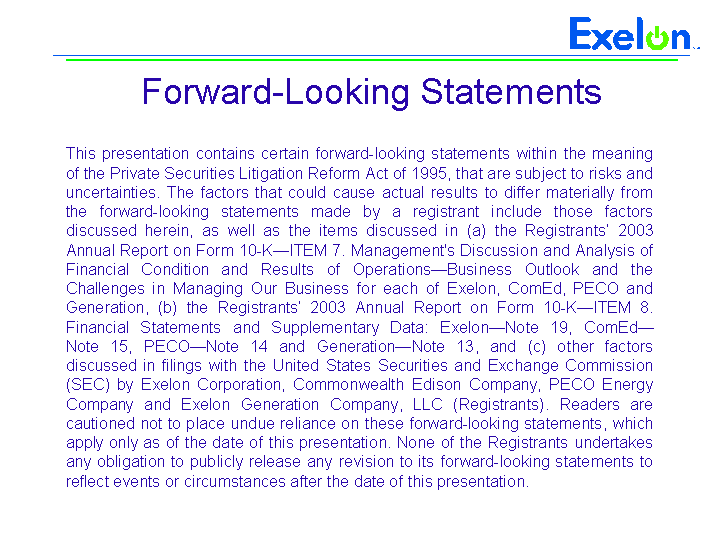
| Forward-Looking Statements This presentation contains certain forward-looking statements within the meaning of the Private Securities Litigation Reform Act of 1995, that are subject to risks and uncertainties. The factors that could cause actual results to differ materially from the forward-looking statements made by a registrant include those factors discussed herein, as well as the items discussed in (a) the Registrants' 2003 Annual Report on Form 10-K-ITEM 7. Management's Discussion and Analysis of Financial Condition and Results of Operations-Business Outlook and the Challenges in Managing Our Business for each of Exelon, ComEd, PECO and Generation, (b) the Registrants' 2003 Annual Report on Form 10-K-ITEM 8. Financial Statements and Supplementary Data: Exelon-Note 19, ComEd- Note 15, PECO-Note 14 and Generation-Note 13, and (c) other factors discussed in filings with the United States Securities and Exchange Commission (SEC) by Exelon Corporation, Commonwealth Edison Company, PECO Energy Company and Exelon Generation Company, LLC (Registrants). Readers are cautioned not to place undue reliance on these forward-looking statements, which apply only as of the date of this presentation. None of the Registrants undertakes any obligation to publicly release any revision to its forward-looking statements to reflect events or circumstances after the date of this presentation. |
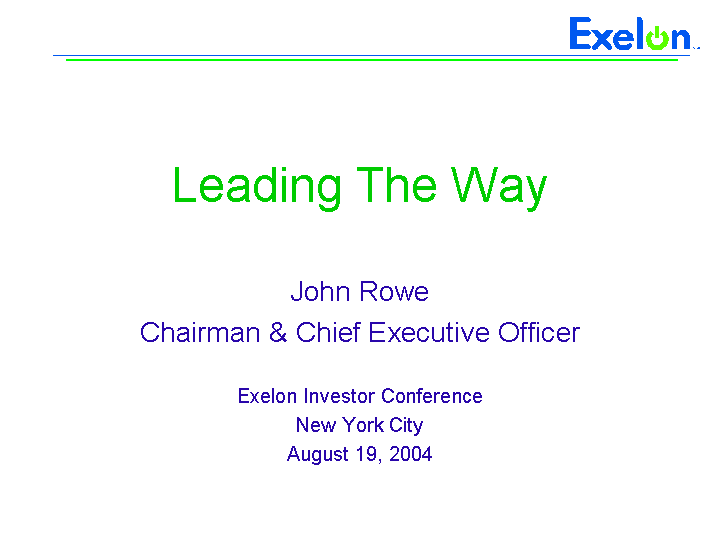
| Leading The Way John Rowe Chairman & Chief Executive Officer Exelon Investor Conference New York City August 19, 2004 |
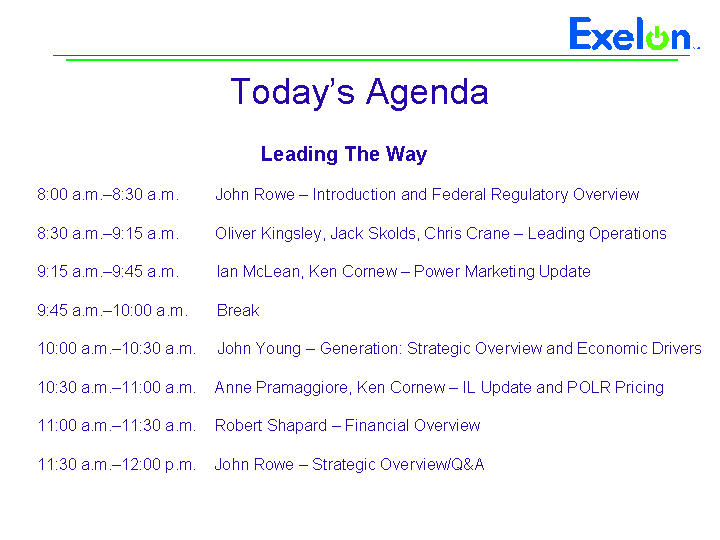
| Today's Agenda Leading The Way 8:00 a.m.-8:30 a.m. John Rowe - Introduction and Federal Regulatory Overview 8:30 a.m.-9:15 a.m. Oliver Kingsley, Jack Skolds, Chris Crane - Leading Operations 9:15 a.m.-9:45 a.m. Ian McLean, Ken Cornew - Power Marketing Update 9:45 a.m.-10:00 a.m. Break 10:00 a.m.-10:30 a.m. John Young - Generation: Strategic Overview and Economic Drivers 10:30 a.m.-11:00 a.m. Anne Pramaggiore, Ken Cornew - IL Update and POLR Pricing 11:00 a.m.-11:30 a.m. Robert Shapard - Financial Overview 11:30 a.m.-12:00 p.m. John Rowe - Strategic Overview/Q&A |
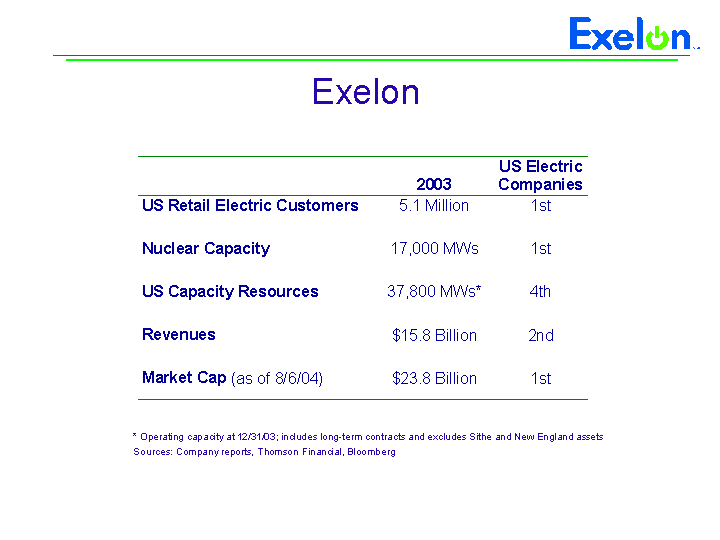
| Exelon * Operating capacity at 12/31/03; includes long-term contracts and excludes Sithe and New England assets Sources: Company reports, Thomson Financial, Bloomberg |
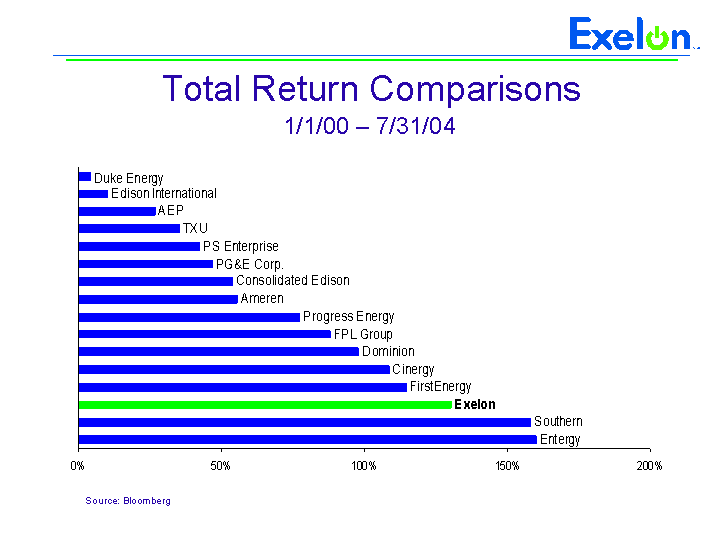
| Total Return Comparisons 1/1/00 - 7/31/04 Source: Bloomberg |
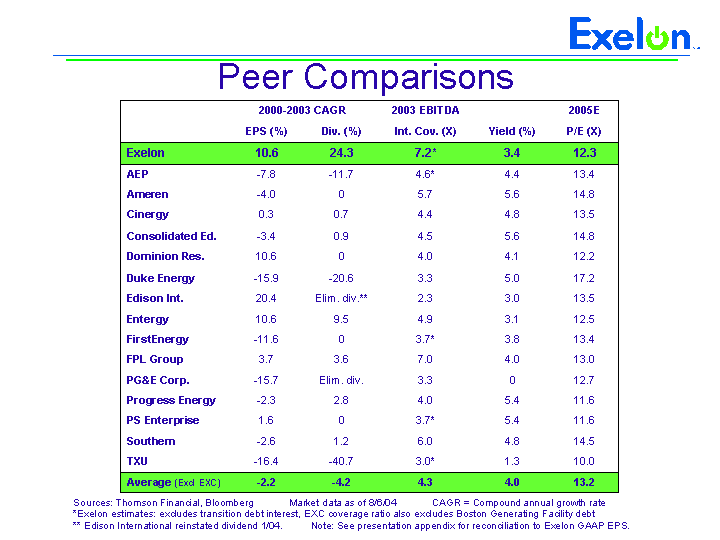
| Peer Comparisons Sources: Thomson Financial, Bloomberg Market data as of 8/6/04 CAGR = Compound annual growth rate *Exelon estimates: excludes transition debt interest, EXC coverage ratio also excludes Boston Generating Facility debt ** Edison International reinstated dividend 1/04. Note: See presentation appendix for reconciliation to Exelon GAAP EPS. 2000-2003 CAGR 2000-2003 CAGR 2003 EBITDA 2005E EPS (%) Div. (%) Int. Cov. (X) Yield (%) P/E (X) Exelon 10.6 24.3 7.2* 3.4 12.3 AEP -7.8 -11.7 4.6* 4.4 13.4 Ameren -4.0 0 5.7 5.6 14.8 Cinergy 0.3 0.7 4.4 4.8 13.5 Consolidated Ed. -3.4 0.9 4.5 5.6 14.8 Dominion Res. 10.6 0 4.0 4.1 12.2 Duke Energy -15.9 -20.6 3.3 5.0 17.2 Edison Int. 20.4 Elim. div.** 2.3 3.0 13.5 Entergy 10.6 9.5 4.9 3.1 12.5 FirstEnergy -11.6 0 3.7* 3.8 13.4 FPL Group 3.7 3.6 7.0 4.0 13.0 PG&E Corp. -15.7 Elim. div. 3.3 0 12.7 Progress Energy -2.3 2.8 4.0 5.4 11.6 PS Enterprise 1.6 0 3.7* 5.4 11.6 Southern -2.6 1.2 6.0 4.8 14.5 TXU -16.4 -40.7 3.0* 1.3 10.0 Average (Excl EXC) -2.2 -4.2 4.3 4.0 13.2 |
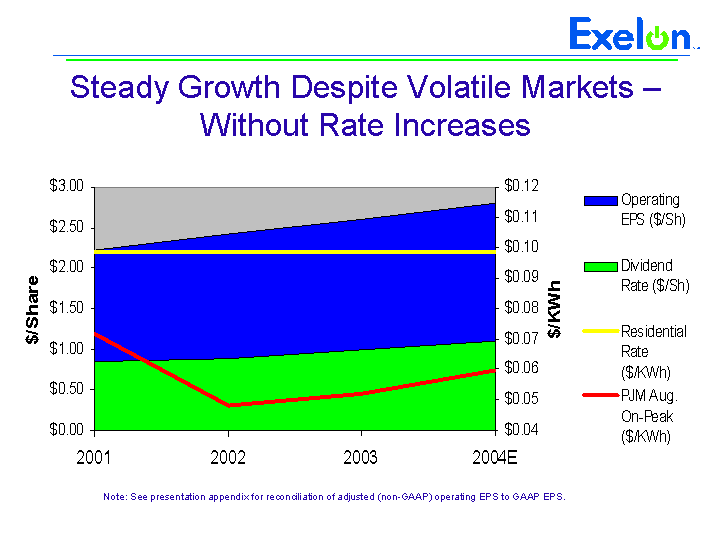
| Steady Growth Despite Volatile Markets - Without Rate Increases Note: See presentation appendix for reconciliation of adjusted (non-GAAP) operating EPS to GAAP EPS. |
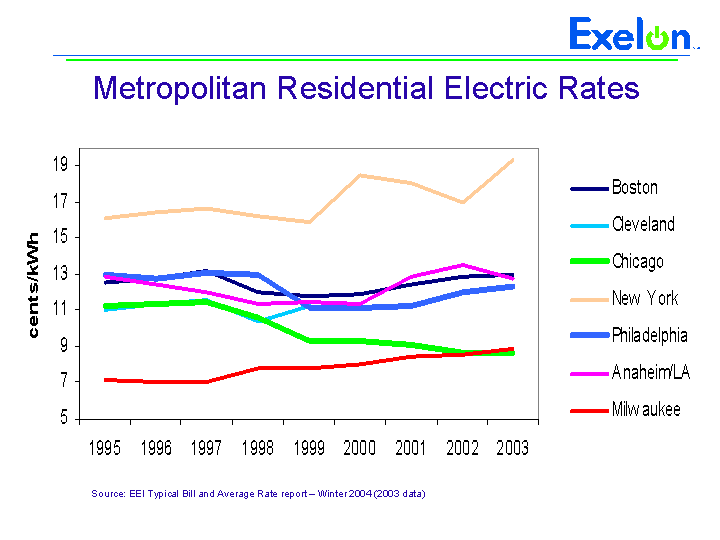
| Example Example Example Metropolitan Residential Electric Rates Source: EEI Typical Bill and Average Rate report - Winter 2004 (2003 data) |
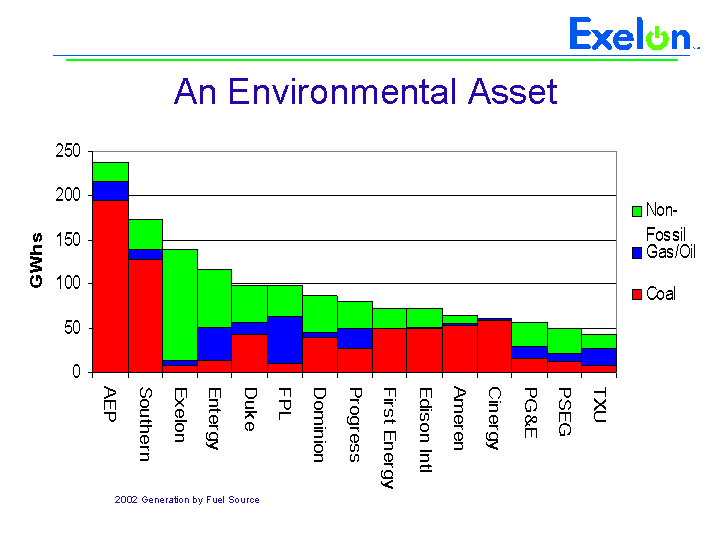
| An Environmental Asset 2002 Generation by Fuel Source |

Appendix:
Reconciliation of GAAP Reported and Adjusted (non-GAAP)
Operating Earnings per Diluted Share
2000 GAAP Reported EPS | $ | 1.44 | ||
| Change in common shares | (0.53 | ) | ||
| Extraordinary items | (0.04 | ) | ||
| Cumulative effect of accounting change | — | |||
| Unicom pre-merger results | 0.79 | |||
| Merger-related costs | 0.34 | |||
| Pro forma merger accounting adjustments | (0.07 | ) | ||
2000 Adjusted (non-GAAP) Operating EPS | $ | 1.93 | ||
2001 GAAP Reported EPS | $ | 2.21 | ||
| Cumulative effect of adopting SFAS No. 133 | (0.02 | ) | ||
| Employee severance costs | 0.05 | |||
| Litigation reserves | 0.01 | |||
| Net loss on investments | 0.01 | |||
| CTC prepayment | (0.01 | ) | ||
| Wholesale rate settlement | (0.01 | ) | ||
| Settlement of transition bond swap | — | |||
2001 Adjusted (non-GAAP) Operating EPS | $ | 2.24 | ||
2002 GAAP Reported EPS | $ | 2.22 | ||
| Cumulative effect of adopting SFAS No. 141 and No. 142 | 0.35 | |||
| Gain on sale of investment in AT&T Wireless | (0.18 | ) | ||
| Employee severance costs | 0.02 | |||
2002 Adjusted (non-GAAP) Operating EPS | $ | 2.41 | ||
2003 GAAP Reported EPS | $ | 1.38 | ||
| Boston Generating impairment | 0.87 | |||
| Charges associated with investment in Sithe Energies, Inc. | 0.27 | |||
| Severance | 0.24 | |||
| Cumulative effect of adopting SFAS No. 143 | (0.17 | ) | ||
| Property tax accrual reductions | (0.07 | ) | ||
| Enterprises’ Services goodwill impairment | 0.03 | |||
| Enterprises’ impairments due to anticipated sale | 0.03 | |||
| March 3 ComEd Settlement Agreement | 0.03 | |||
2003 Adjusted (non-GAAP) Operating EPS | $ | 2.61 |
Note:EPS figures reflect 2-for-1 stock split effective 5/5/04. Three-year 2003/2000 compound annual growth rate (CAGR): $1.38/$1.44 =
- -1.4% based on GAAP reported results. Three-year 2003/2000 CAGR: $2.61/$1.93 = 10.6% based on adjusted (non-GAAP) operating results.

Appendix:
Stock Ownership—John W. Rowe
As of August 16, 2004:
Stock ownership goal under Exelon’s stock ownership requirement: 229,446
Shares owned by Mr. Rowe (including deferred shares and shares held by his spouse): 387,780
Stock options held by Mr. Rowe:
Vested: 1,997,239
Unvested: 795,833
Note: Mr. Rowe has a 10b5-1 plan to exercise and sell before the end of February 2005 the remaining 171,872 options under the original option grant he received when he became Chairman and CEO of Unicom in March 1998.
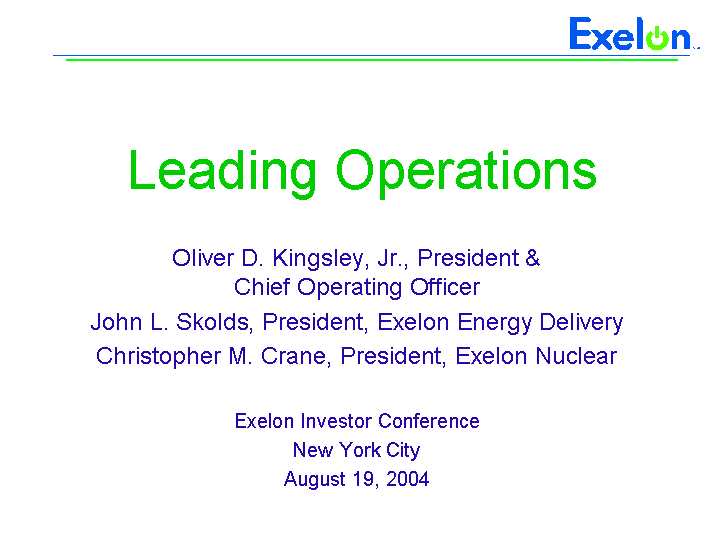
| Leading Operations Oliver D. Kingsley, Jr., President & Chief Operating Officer John L. Skolds, President, Exelon Energy Delivery Christopher M. Crane, President, Exelon Nuclear Exelon Investor Conference New York City August 19, 2004 |
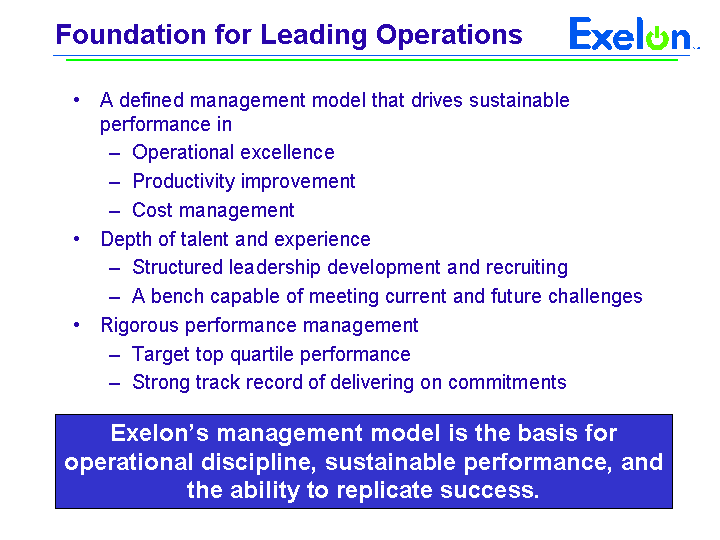
| Foundation for Leading Operations A defined management model that drives sustainable performance in Operational excellence Productivity improvement Cost management Depth of talent and experience Structured leadership development and recruiting A bench capable of meeting current and future challenges Rigorous performance management Target top quartile performance Strong track record of delivering on commitments Exelon's management model is the basis for operational discipline, sustainable performance, and the ability to replicate success. |
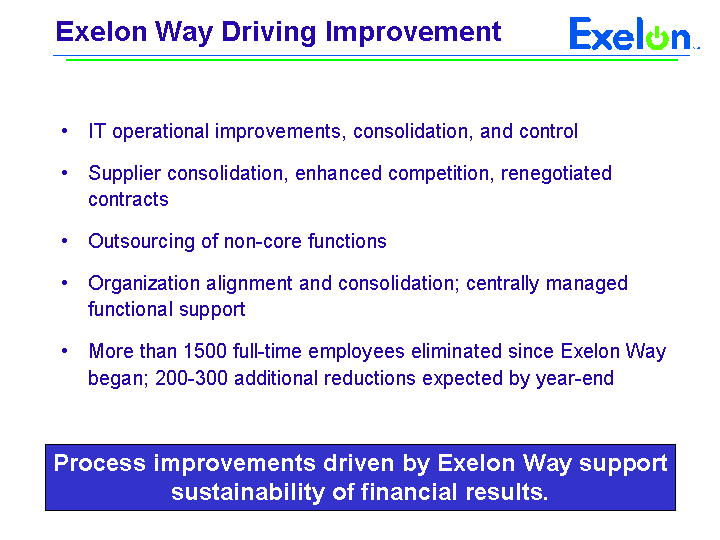
| Exelon Way Driving Improvement Process improvements driven by Exelon Way support sustainability of financial results. IT operational improvements, consolidation, and control Supplier consolidation, enhanced competition, renegotiated contracts Outsourcing of non-core functions Organization alignment and consolidation; centrally managed functional support More than 1500 full-time employees eliminated since Exelon Way began; 200-300 additional reductions expected by year-end |
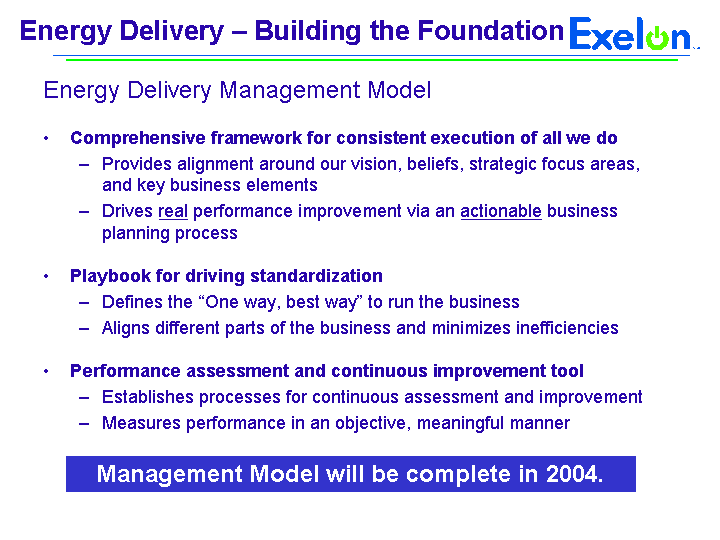
| Energy Delivery Management Model Comprehensive framework for consistent execution of all we do Provides alignment around our vision, beliefs, strategic focus areas, and key business elements Drives real performance improvement via an actionable business planning process Playbook for driving standardization Defines the "One way, best way" to run the business Aligns different parts of the business and minimizes inefficiencies Performance assessment and continuous improvement tool Establishes processes for continuous assessment and improvement Measures performance in an objective, meaningful manner Energy Delivery - Building the Foundation Management Model will be complete in 2004. |
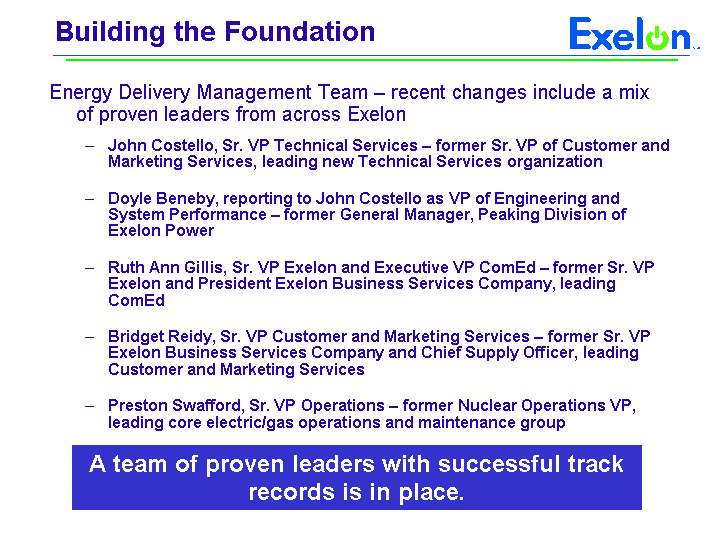
| Building the Foundation A team of proven leaders with successful track records is in place. Energy Delivery Management Team - recent changes include a mix of proven leaders from across Exelon John Costello, Sr. VP Technical Services - former Sr. VP of Customer and Marketing Services, leading new Technical Services organization Doyle Beneby, reporting to John Costello as VP of Engineering and System Performance - former General Manager, Peaking Division of Exelon Power Ruth Ann Gillis, Sr. VP Exelon and Executive VP ComEd - former Sr. VP Exelon and President Exelon Business Services Company, leading ComEd Bridget Reidy, Sr. VP Customer and Marketing Services - former Sr. VP Exelon Business Services Company and Chief Supply Officer, leading Customer and Marketing Services Preston Swafford, Sr. VP Operations - former Nuclear Operations VP, leading core electric/gas operations and maintenance group |
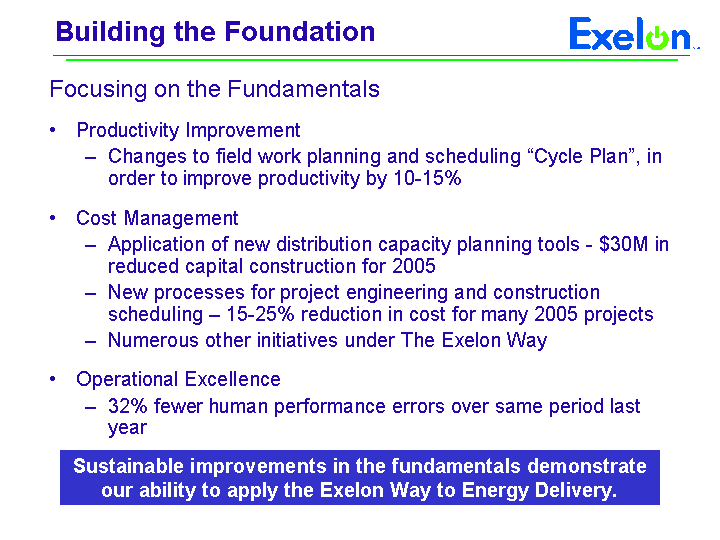
| Building the Foundation Focusing on the Fundamentals Productivity Improvement Changes to field work planning and scheduling "Cycle Plan", in order to improve productivity by 10-15% Cost Management Application of new distribution capacity planning tools - $30M in reduced capital construction for 2005 New processes for project engineering and construction scheduling - 15-25% reduction in cost for many 2005 projects Numerous other initiatives under The Exelon Way Operational Excellence 32% fewer human performance errors over same period last year Sustainable improvements in the fundamentals demonstrate our ability to apply the Exelon Way to Energy Delivery. |
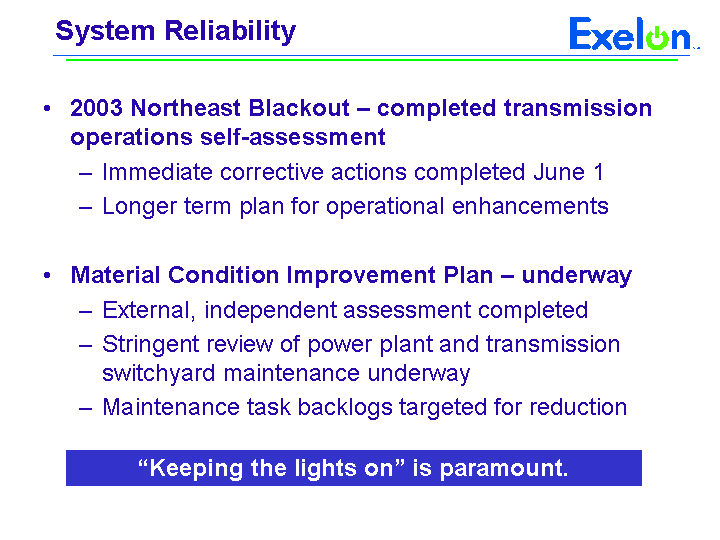
| System Reliability 2003 Northeast Blackout - completed transmission operations self-assessment Immediate corrective actions completed June 1 Longer term plan for operational enhancements Material Condition Improvement Plan - underway External, independent assessment completed Stringent review of power plant and transmission switchyard maintenance underway Maintenance task backlogs targeted for reduction "Keeping the lights on" is paramount. |
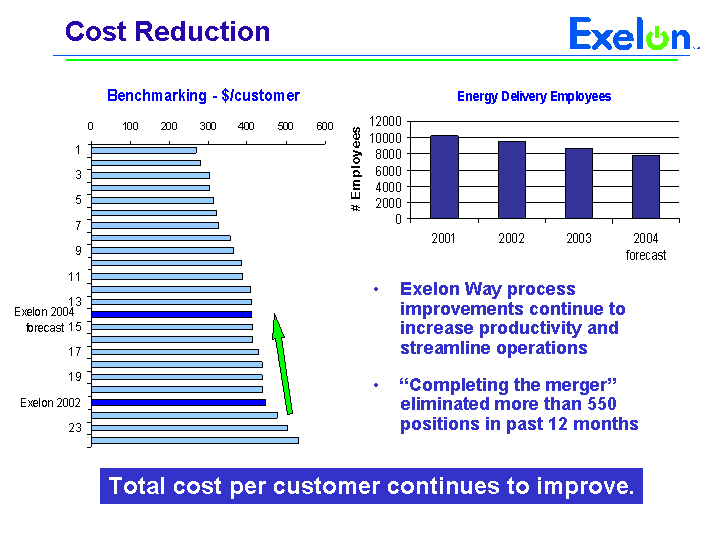
| Cost Reduction Total cost per customer continues to improve. Exelon Way process improvements continue to increase productivity and streamline operations "Completing the merger" eliminated more than 550 positions in past 12 months |
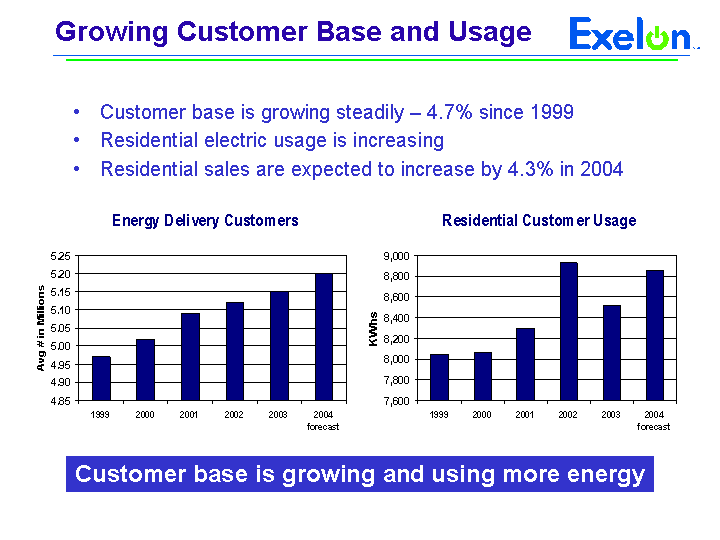
| Customer base is growing and using more energy Year EED 1999 4.97 2000 5.02 2001 5.09 2002 5.12 2003 5.15 2004 forecast 5.2 1999 8042 2000 8069 2001 8299 2002 8926 2003 8518 2004 forecast 8855 Customer base is growing steadily - 4.7% since 1999 Residential electric usage is increasing Residential sales are expected to increase by 4.3% in 2004 Growing Customer Base and Usage |
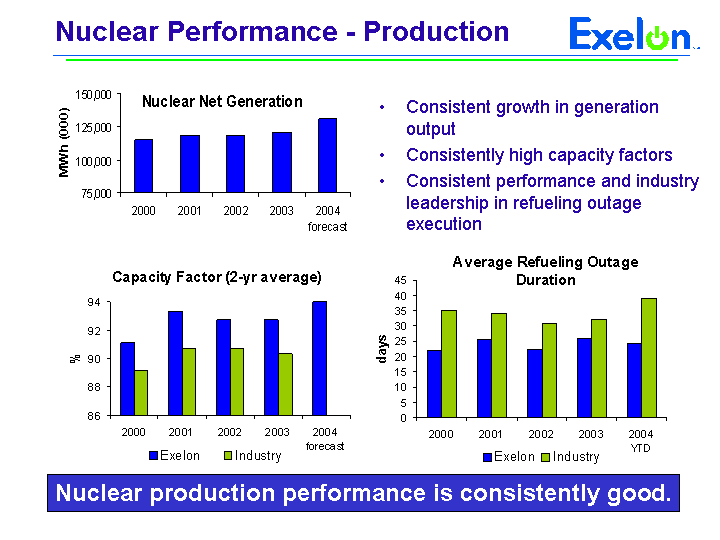
| Nuclear Performance - Production Consistent growth in generation output Consistently high capacity factors Consistent performance and industry leadership in refueling outage execution Nuclear production performance is consistently good. |
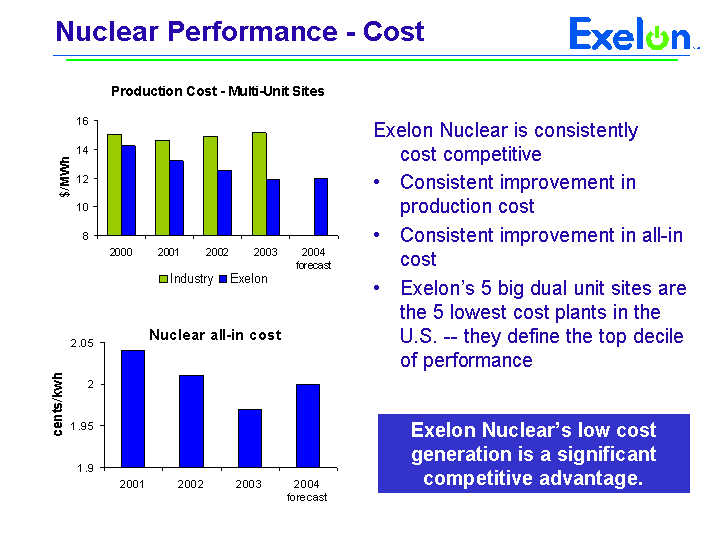
| Nuclear Performance - Cost Exelon Nuclear is consistently cost competitive Consistent improvement in production cost Consistent improvement in all-in cost Exelon's 5 big dual unit sites are the 5 lowest cost plants in the U.S. -- they define the top decile of performance Exelon Nuclear's low cost generation is a significant competitive advantage. |

| Management Strength & Continuity Exelon Nuclear has a strong bench of skilled, seasoned leaders The senior management team has extensive Exelon experience Key nuclear senior corporate management have experience as Exelon site vice presidents All ten site vice presidents have served as plant managers We maintain a balance of external recruits and internally developed talent We enforce a planned career development experience program for all key operating jobs that requires specific plant experience Retention is under control, and Nuclear has been able to supply talent throughout the company Exelon Nuclear can count on management continuity and depth of experience. |
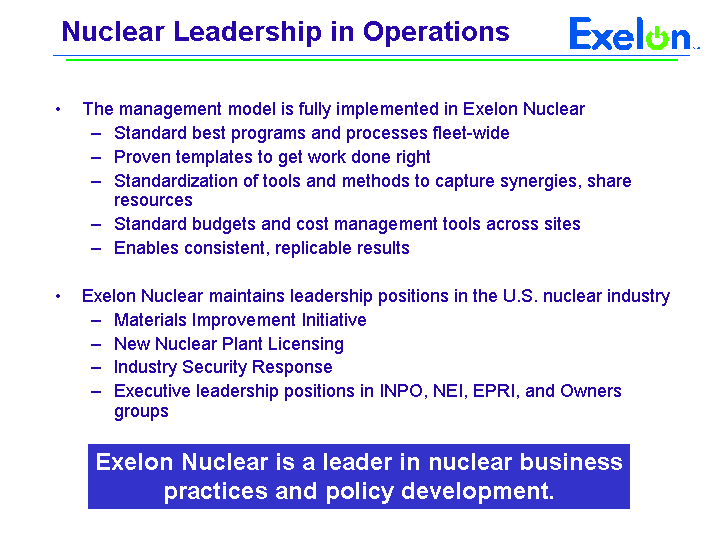
| Nuclear Leadership in Operations The management model is fully implemented in Exelon Nuclear Standard best programs and processes fleet-wide Proven templates to get work done right Standardization of tools and methods to capture synergies, share resources Standard budgets and cost management tools across sites Enables consistent, replicable results Exelon Nuclear maintains leadership positions in the U.S. nuclear industry Materials Improvement Initiative New Nuclear Plant Licensing Industry Security Response Executive leadership positions in INPO, NEI, EPRI, and Owners groups Exelon Nuclear is a leader in nuclear business practices and policy development. |
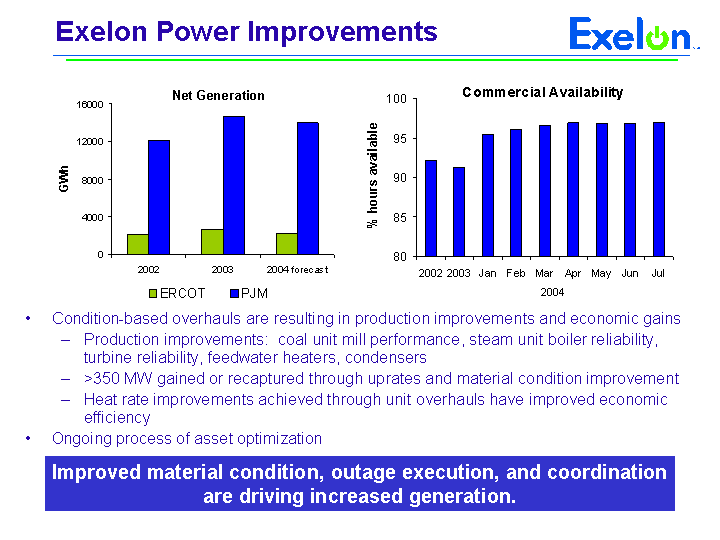
| Exelon Power Improvements Condition-based overhauls are resulting in production improvements and economic gains Production improvements: coal unit mill performance, steam unit boiler reliability, turbine reliability, feedwater heaters, condensers >350 MW gained or recaptured through uprates and material condition improvement Heat rate improvements achieved through unit overhauls have improved economic efficiency Ongoing process of asset optimization Improved material condition, outage execution, and coordination are driving increased generation. 2004 |
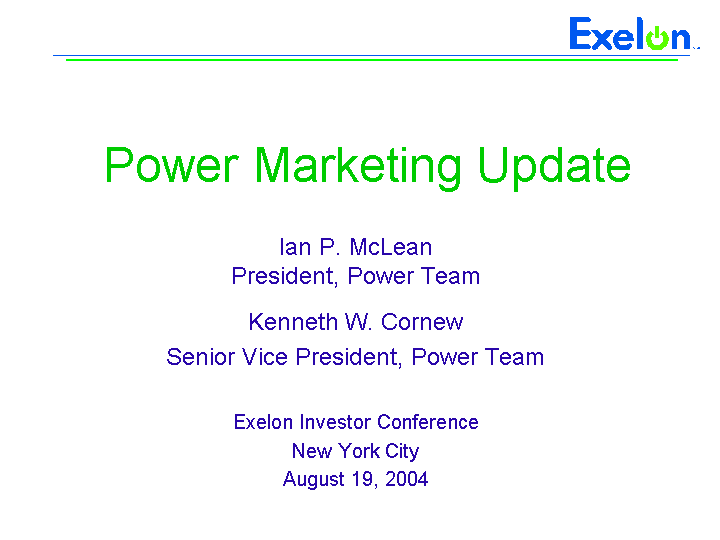
| Power Marketing Update Ian P. McLean President, Power Team Kenneth W. Cornew Senior Vice President, Power Team Exelon Investor Conference New York City August 19, 2004 |
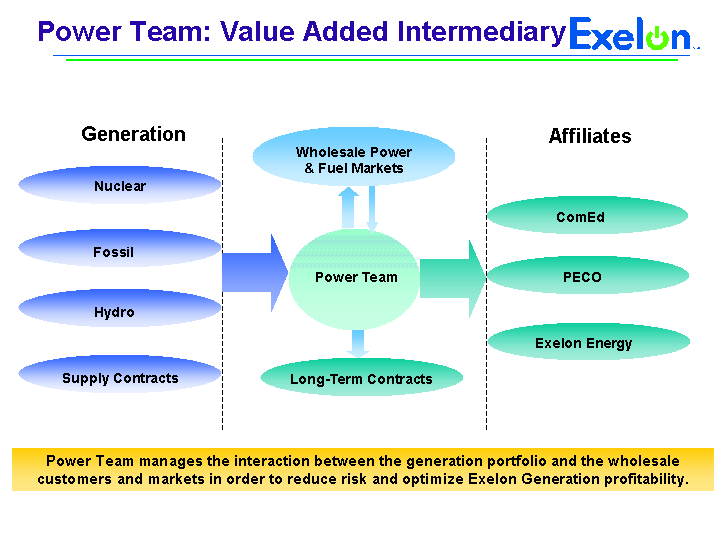
| Power Team: Value Added Intermediary Nuclear Fossil Hydro Generation Power Team ComEd PECO Wholesale Power & Fuel Markets Affiliates Supply Contracts Power Team manages the interaction between the generation portfolio and the wholesale customers and markets in order to reduce risk and optimize Exelon Generation profitability. Long-Term Contracts Exelon Energy |
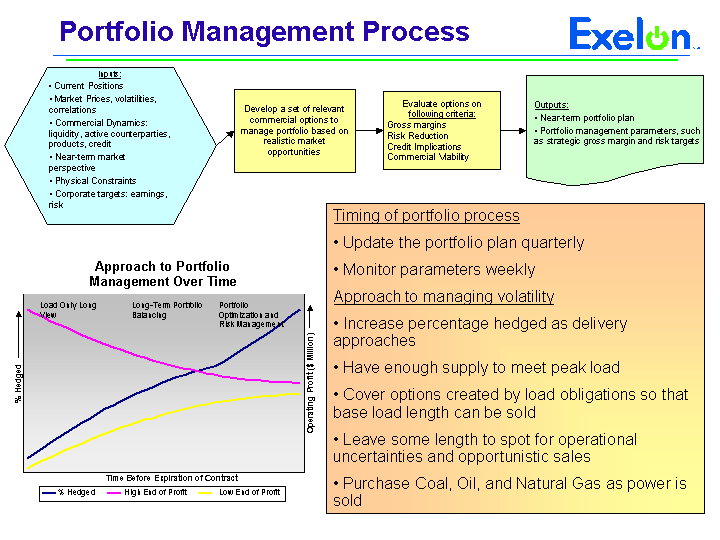
| Portfolio Management Process Approach to Portfolio Management Over Time Time Before Expiration of Contract % Hedged % Hedged High End of Profit Low End of Profit Load Only Long View Long-Term Portfolio Balancing Portfolio Optimization and Risk Management Operating Profit ($ Million) Develop a set of relevant commercial options to manage portfolio based on realistic market opportunities Evaluate options on following criteria: Gross margins Risk Reduction Credit Implications Commercial Viability Outputs: Near-term portfolio plan Portfolio management parameters, such as strategic gross margin and risk targets Inputs: Current Positions Market Prices, volatilities, correlations Commercial Dynamics: liquidity, active counterparties, products, credit Near-term market perspective Physical Constraints Corporate targets: earnings, risk Timing of portfolio process Update the portfolio plan quarterly Monitor parameters weekly Approach to managing volatility Increase percentage hedged as delivery approaches Have enough supply to meet peak load Cover options created by load obligations so that base load length can be sold Leave some length to spot for operational uncertainties and opportunistic sales Purchase Coal, Oil, and Natural Gas as power is sold |
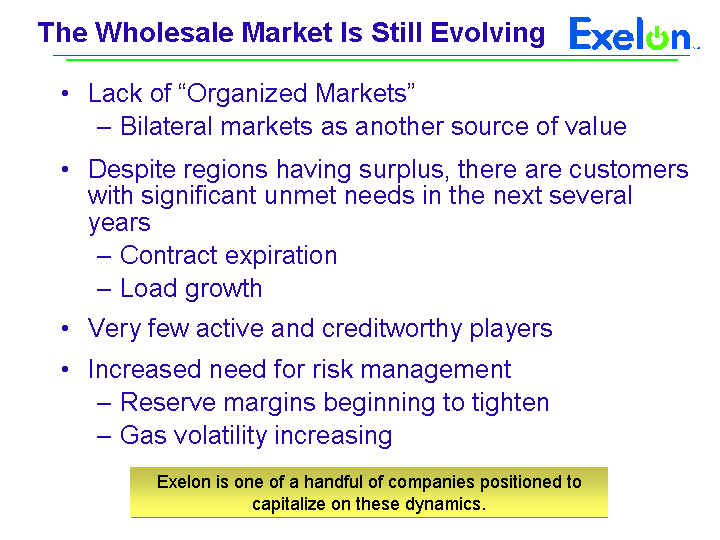
| The Wholesale Market Is Still Evolving Lack of "Organized Markets" Bilateral markets as another source of value Despite regions having surplus, there are customers with significant unmet needs in the next several years Contract expiration Load growth Very few active and creditworthy players Increased need for risk management Reserve margins beginning to tighten Gas volatility increasing Exelon is one of a handful of companies positioned to capitalize on these dynamics. |
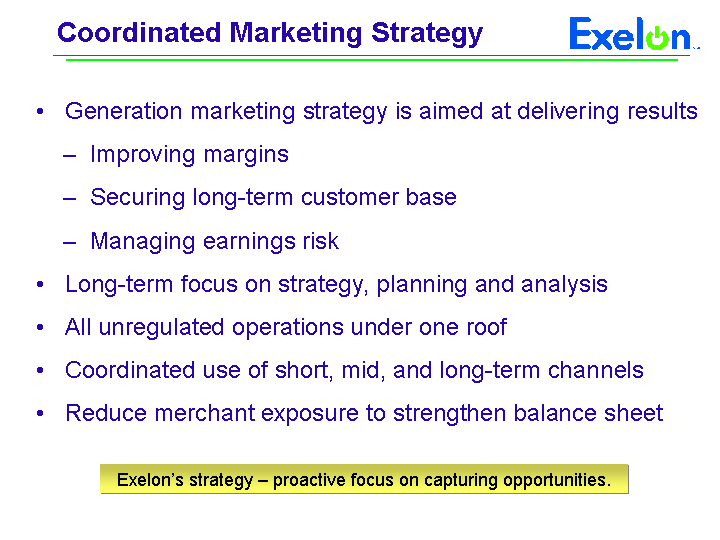
| Coordinated Marketing Strategy Generation marketing strategy is aimed at delivering results Improving margins Securing long-term customer base Managing earnings risk Long-term focus on strategy, planning and analysis All unregulated operations under one roof Coordinated use of short, mid, and long-term channels Reduce merchant exposure to strengthen balance sheet Exelon's strategy - proactive focus on capturing opportunities. |
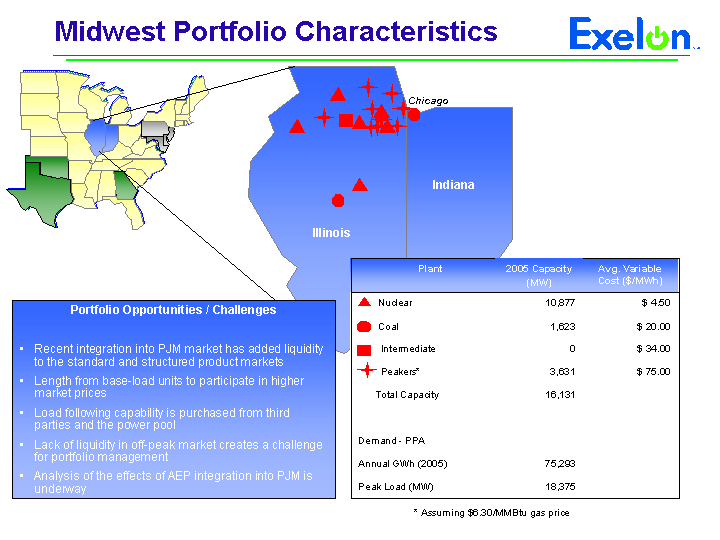
| Midwest Portfolio Characteristics Indiana Illinois Chicago Portfolio Opportunities / Challenges Recent integration into PJM market has added liquidity to the standard and structured product markets Length from base-load units to participate in higher market prices Load following capability is purchased from third parties and the power pool Lack of liquidity in off-peak market creates a challenge for portfolio management Analysis of the effects of AEP integration into PJM is underway 18,375 Peak Load (MW) 75,293 Annual GWh (2005) Demand - PPA 16,131 Total Capacity $ 75.00 3,631 Peakers* $ 34.00 0 Intermediate $ 20.00 1,623 Coal $ 4.50 10,877 Nuclear Avg. Variable Cost ($/MWh) Plant 2005 Capacity (MW) * Assuming $6.30/MMBtu gas price |
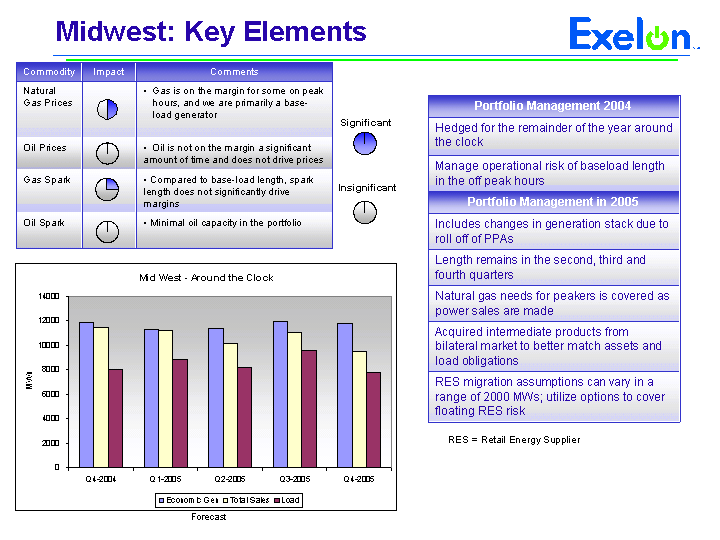
| Midwest: Key Elements Significant Insignificant Portfolio Management 2004 Hedged for the remainder of the year around the clock Manage operational risk of baseload length in the off peak hours Portfolio Management in 2005 Includes changes in generation stack due to roll off of PPAs Length remains in the second, third and fourth quarters Natural gas needs for peakers is covered as power sales are made Acquired intermediate products from bilateral market to better match assets and load obligations RES migration assumptions can vary in a range of 2000 MWs; utilize options to cover floating RES risk Commodity Impact Comments Natural Gas Prices Gas is on the margin for some on peak hours, and we are primarily a base-load generator Oil Prices Oil is not on the margin a significant amount of time and does not drive prices Gas Spark Compared to base-load length, spark length does not significantly drive margins Oil Spark Minimal oil capacity in the portfolio RES = Retail Energy Supplier Forecast |
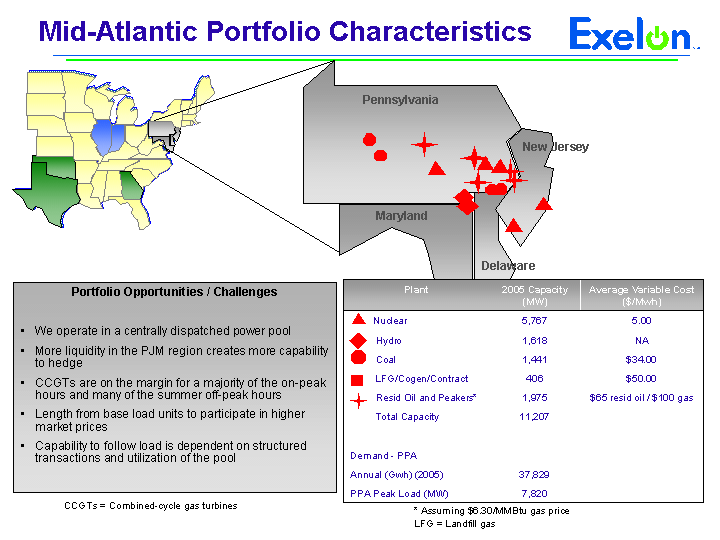
| Pennsylvania Maryland New Jersey Delaware Mid-Atlantic Portfolio Characteristics Plant 2005 Capacity (MW) Average Variable Cost ($/Mwh) Nuclear 5,767 5.00 Hydro 1,618 NA Coal 1,441 $34.00 LFG/Cogen/Contract 406 $50.00 Resid Oil and Peakers* 1,975 $65 resid oil / $100 gas Total Capacity 11,207 Demand - PPA Annual (Gwh) (2005) 37,829 PPA Peak Load (MW) 7,820 Portfolio Opportunities / Challenges We operate in a centrally dispatched power pool More liquidity in the PJM region creates more capability to hedge CCGTs are on the margin for a majority of the on-peak hours and many of the summer off-peak hours Length from base load units to participate in higher market prices Capability to follow load is dependent on structured transactions and utilization of the pool * Assuming $6.30/MMBtu gas price LFG = Landfill gas CCGTs = Combined-cycle gas turbines |
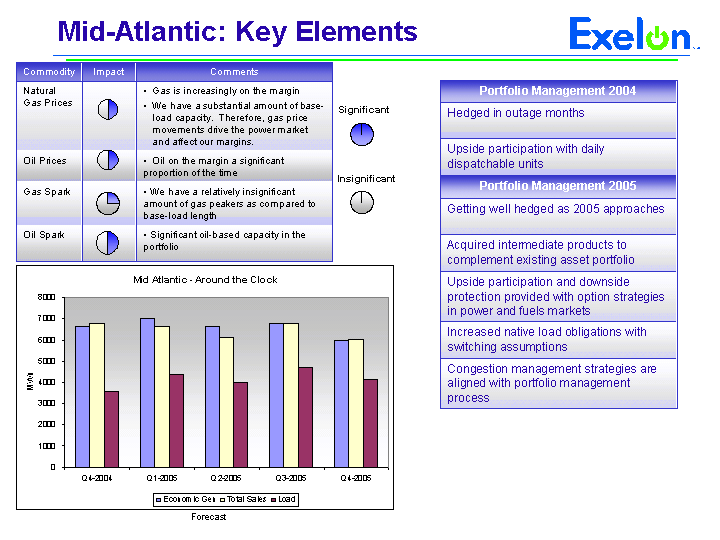
| Mid-Atlantic: Key Elements Significant Insignificant Commodity Impact Comments Natural Gas Prices Gas is increasingly on the margin We have a substantial amount of base-load capacity. Therefore, gas price movements drive the power market and affect our margins. Oil Prices Oil on the margin a significant proportion of the time Gas Spark We have a relatively insignificant amount of gas peakers as compared to base-load length Oil Spark Significant oil-based capacity in the portfolio Portfolio Management 2004 Hedged in outage months Upside participation with daily dispatchable units Portfolio Management 2005 Getting well hedged as 2005 approaches Acquired intermediate products to complement existing asset portfolio Upside participation and downside protection provided with option strategies in power and fuels markets Increased native load obligations with switching assumptions Congestion management strategies are aligned with portfolio management process Forecast |
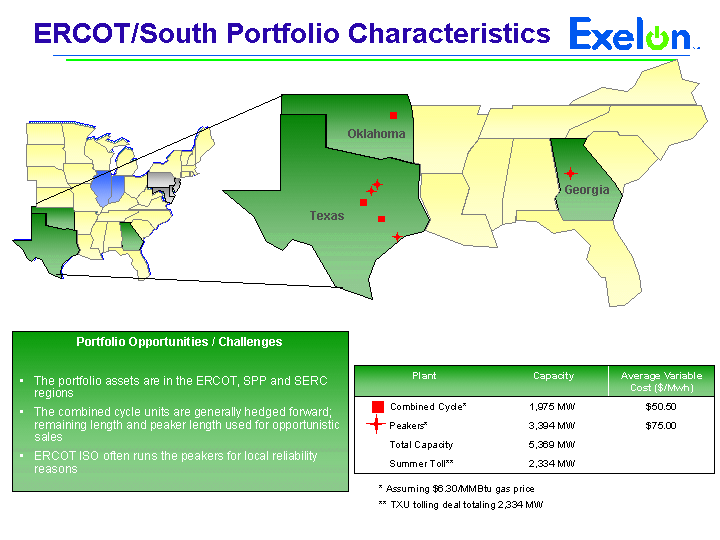
| ERCOT/South Portfolio Characteristics Plant Capacity Average Variable Cost ($/Mwh) Combined Cycle* 1,975 MW $50.50 Peakers* 3,394 MW $75.00 Total Capacity 5,369 MW Summer Toll** 2,334 MW * Assuming $6.30/MMBtu gas price ** TXU tolling deal totaling 2,334 MW Texas Oklahoma Georgia Portfolio Opportunities / Challenges The portfolio assets are in the ERCOT, SPP and SERC regions The combined cycle units are generally hedged forward; remaining length and peaker length used for opportunistic sales ERCOT ISO often runs the peakers for local reliability reasons |
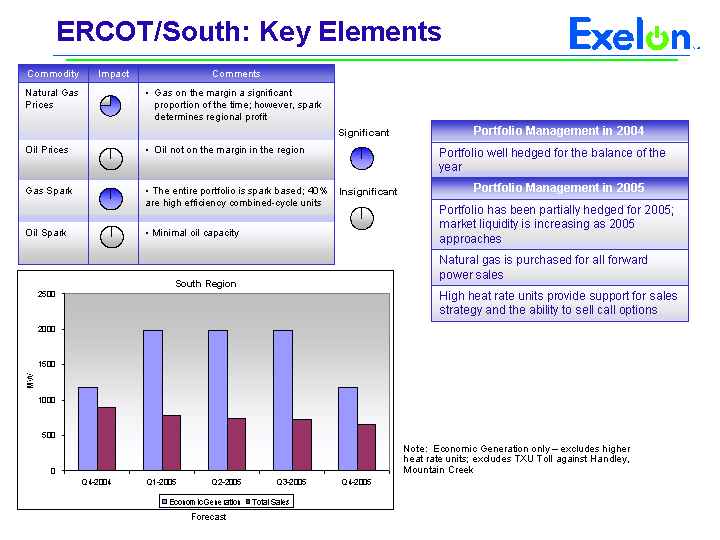
| ERCOT/South: Key Elements Significant Insignificant Minimal oil capacity Oil Spark The entire portfolio is spark based; 40% are high efficiency combined-cycle units Gas Spark Oil not on the margin in the region Oil Prices Gas on the margin a significant proportion of the time; however, spark determines regional profit Natural Gas Prices Comments Impact On Our Portfoli o Commodity Portfolio Management in 2004 Portfolio well hedged for the balance of the year Portfolio Management in 2005 Portfolio has been partially hedged for 2005; market liquidity is increasing as 2005 approaches Natural gas is purchased for all forward power sales High heat rate units provide support for sales strategy and the ability to sell call options Note: Economic Generation only - excludes higher heat rate units; excludes TXU Toll against Handley, Mountain Creek Forecast |
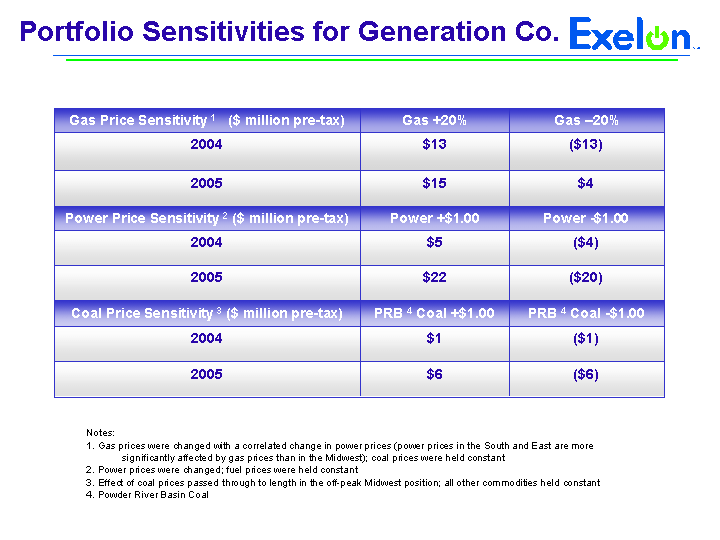
| Portfolio Sensitivities for Generation Co. Gas Price Sensitivity 1 ($ million pre-tax) Gas +20% Gas -20% 2004 $13 ($13) 2005 $15 $4 Power Price Sensitivity 2 ($ million pre-tax) Power +$1.00 Power -$1.00 2004 $5 ($4) 2005 $22 ($20) Coal Price Sensitivity 3 ($ million pre-tax) PRB 4 Coal +$1.00 PRB 4 Coal -$1.00 2004 $1 ($1) 2005 $6 ($6) Notes: 1. Gas prices were changed with a correlated change in power prices (power prices in the South and East are more significantly affected by gas prices than in the Midwest); coal prices were held constant 2. Power prices were changed; fuel prices were held constant 3. Effect of coal prices passed through to length in the off-peak Midwest position; all other commodities held constant 4. Powder River Basin Coal |
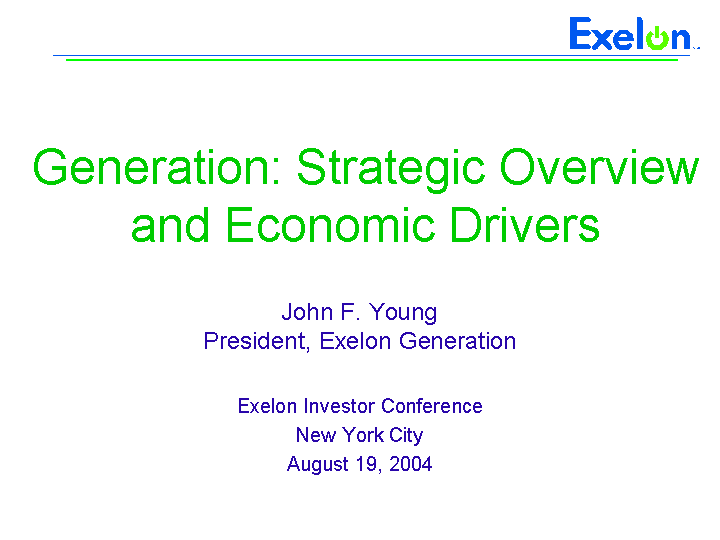
| Generation: Strategic Overview and Economic Drivers John F. Young President, Exelon Generation Exelon Investor Conference New York City August 19, 2004 |
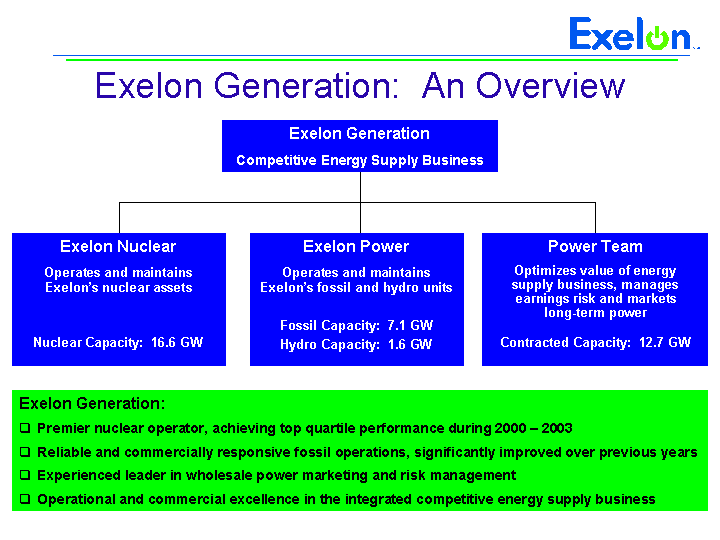
| Exelon Generation: An Overview Exelon Generation Competitive Energy Supply Business Exelon Nuclear Operates and maintains Exelon's nuclear assets Nuclear Capacity: 16.6 GW Exelon Power Operates and maintains Exelon's fossil and hydro units Fossil Capacity: 7.1 GW Hydro Capacity: 1.6 GW Power Team Optimizes value of energy supply business, manages earnings risk and markets long-term power Contracted Capacity: 12.7 GW Exelon Generation: Premier nuclear operator, achieving top quartile performance during 2000 - 2003 Reliable and commercially responsive fossil operations, significantly improved over previous years Experienced leader in wholesale power marketing and risk management Operational and commercial excellence in the integrated competitive energy supply business |
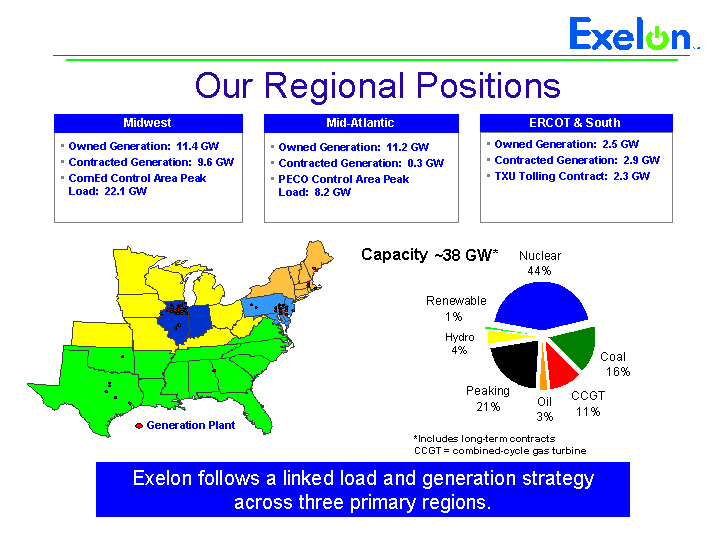
| Nuclear 44% Oil 3% Renewable 1% Peaking 21% CCGT 11% Hydro 4% Coal 16% Capacity ~38 GW* *Includes long-term contracts CCGT = combined-cycle gas turbine Our Regional Positions Owned Generation: 2.5 GW Contracted Generation: 2.9 GW TXU Tolling Contract: 2.3 GW ERCOT & South Owned Generation: 11.2 GW Contracted Generation: 0.3 GW PECO Control Area Peak Load: 8.2 GW Mid-Atlantic Owned Generation: 11.4 GW Contracted Generation: 9.6 GW ComEd Control Area Peak Load: 22.1 GW Midwest Exelon follows a linked load and generation strategy across three primary regions. |
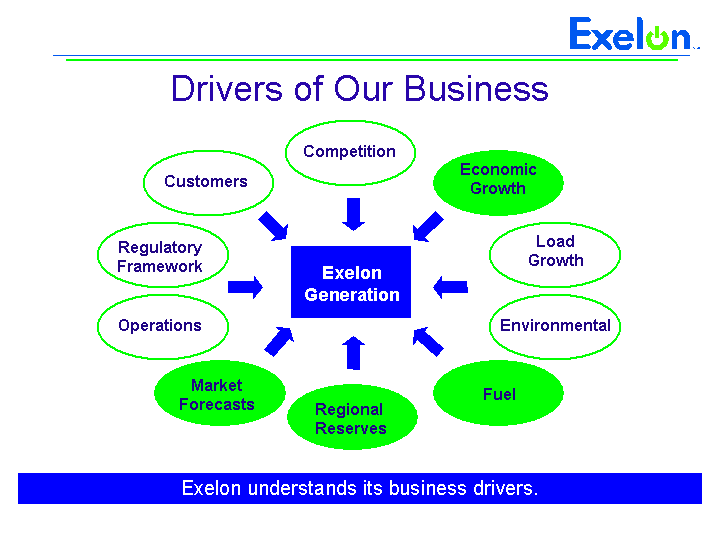
| Drivers of Our Business Exelon Generation Regional Reserves Fuel Load Growth Operations Regulatory Framework Competition Economic Growth Market Forecasts Customers Environmental Exelon understands its business drivers. |
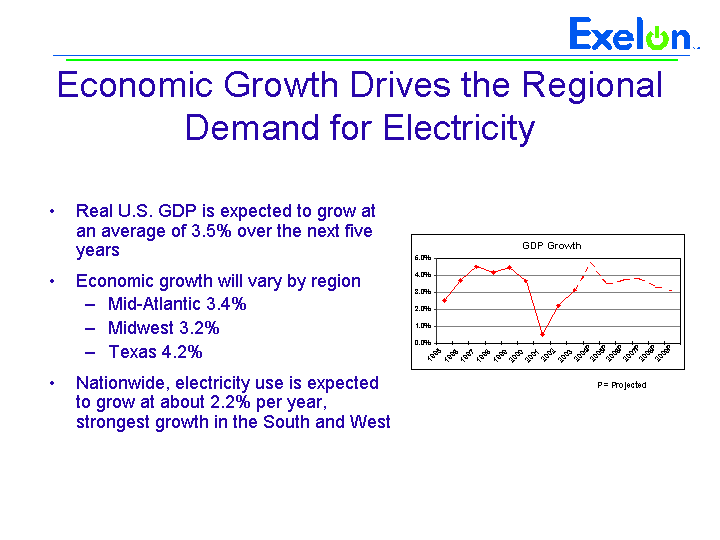
| Real U.S. GDP is expected to grow at an average of 3.5% over the next five years Economic growth will vary by region Mid-Atlantic 3.4% Midwest 3.2% Texas 4.2% Nationwide, electricity use is expected to grow at about 2.2% per year, strongest growth in the South and West Economic Growth Drives the Regional Demand for Electricity GDP Growth 0.0% 1.0% 2.0% 3.0% 4.0% 5.0% 1995 1996 1997 1998 1999 2000 2001 2002 2003 2004P 2005P 2006P 2007P 2008P 2009P P = Projected |
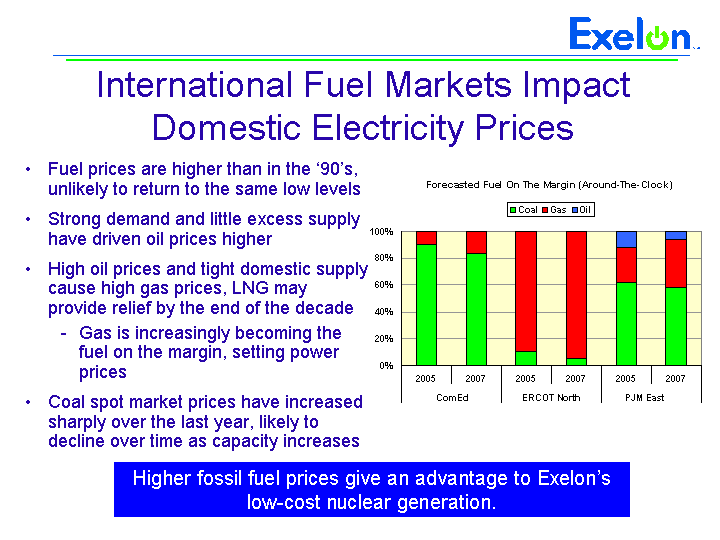
| 0% 20% 40% 60% 80% 100% 2005 2007 2005 2007 2005 2007 ComEd ERCOT North PJM East Coal Gas Oil Fuel prices are higher than in the '90's, unlikely to return to the same low levels Strong demand and little excess supply have driven oil prices higher High oil prices and tight domestic supply cause high gas prices, LNG may provide relief by the end of the decade Gas is increasingly becoming the fuel on the margin, setting power prices Coal spot market prices have increased sharply over the last year, likely to decline over time as capacity increases International Fuel Markets Impact Domestic Electricity Prices Higher fossil fuel prices give an advantage to Exelon's low-cost nuclear generation. Forecasted Fuel On The Margin (Around-The-Clock) |
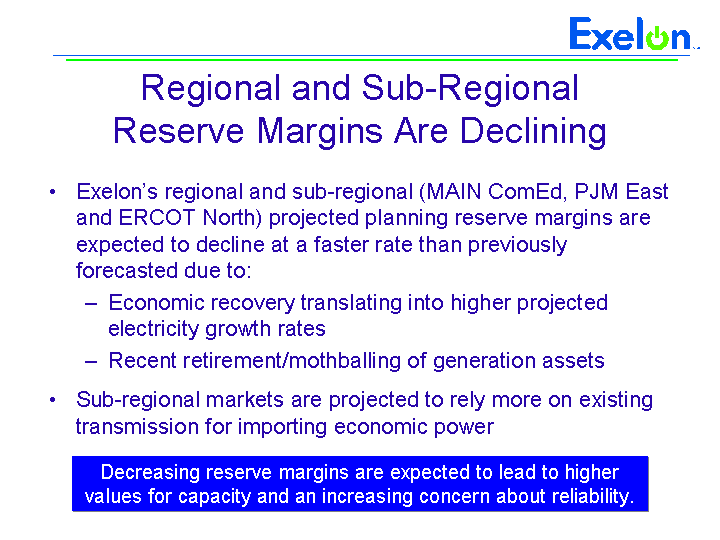
| Regional and Sub-Regional Reserve Margins Are Declining Exelon's regional and sub-regional (MAIN ComEd, PJM East and ERCOT North) projected planning reserve margins are expected to decline at a faster rate than previously forecasted due to: Economic recovery translating into higher projected electricity growth rates Recent retirement/mothballing of generation assets Sub-regional markets are projected to rely more on existing transmission for importing economic power Decreasing reserve margins are expected to lead to higher values for capacity and an increasing concern about reliability. |
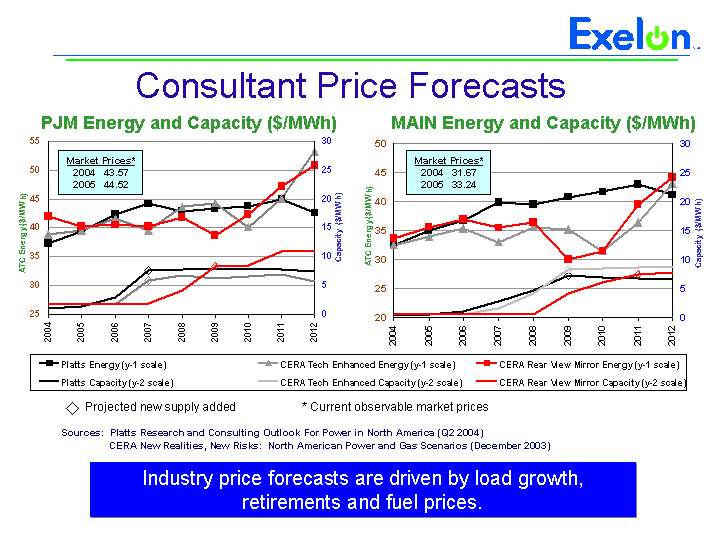
| PJM Energy and Capacity ($/MWh) MAIN Energy and Capacity ($/MWh) Consultant Price Forecasts Sources: Platts Research and Consulting Outlook For Power in North America (Q2 2004) CERA New Realities, New Risks: North American Power and Gas Scenarios (December 2003) Industry price forecasts are driven by load growth, retirements and fuel prices. Platts Energy (y-1 scale) CERA Tech Enhanced Energy (y-1 scale) CERA Rear View Mirror Energy (y-1 scale) Platts Capacity (y-2 scale) CERA Tech Enhanced Capacity (y-2 scale) CERA Rear View Mirror Capacity (y-2 scale) Projected new supply added * Current observable market prices Market Prices* 2004 31.67 2005 33.24 ATC Energy ($/MWh) Capacity ($/MWh) ATC Energy ($/MWh) Capacity ($/MWh) Market Prices* 2004 43.57 2005 44.52 |
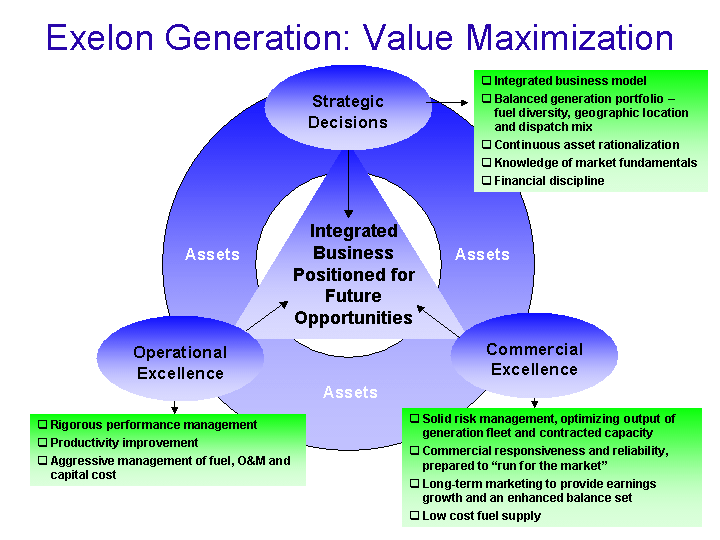
| Exelon Generation: Value Maximization Integrated business model Balanced generation portfolio - fuel diversity, geographic location and dispatch mix Continuous asset rationalization Knowledge of market fundamentals Financial discipline Rigorous performance management Productivity improvement Aggressive management of fuel, O&M and capital cost Operational Excellence Integrated Business Positioned for Future Opportunities Strategic Decisions Commercial Excellence Solid risk management, optimizing output of generation fleet and contracted capacity Commercial responsiveness and reliability, prepared to "run for the market" Long-term marketing to provide earnings growth and an enhanced balance set Low cost fuel supply Assets Assets Assets |
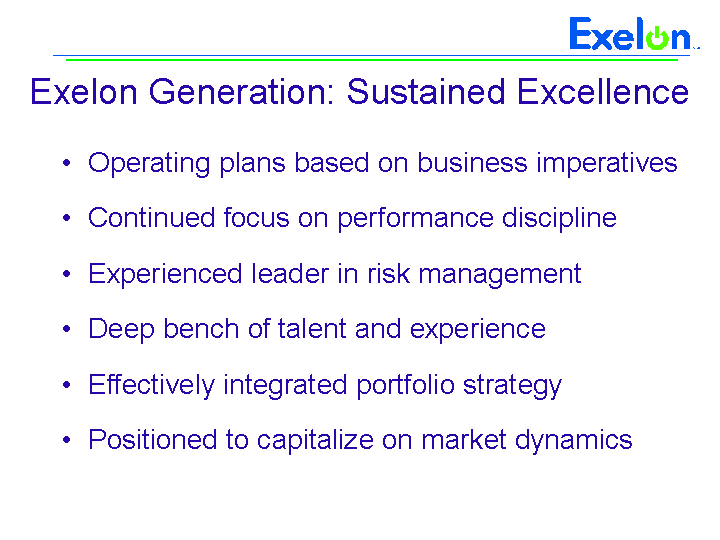
| Exelon Generation: Sustained Excellence Operating plans based on business imperatives Continued focus on performance discipline Experienced leader in risk management Deep bench of talent and experience Effectively integrated portfolio strategy Positioned to capitalize on market dynamics |
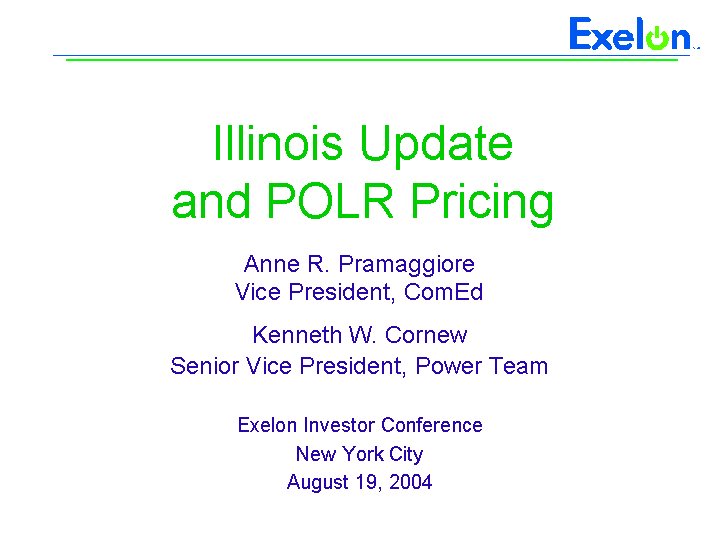
| Illinois Update and POLR Pricing Anne R. Pramaggiore Vice President, ComEd Kenneth W. Cornew Senior Vice President, Power Team Exelon Investor Conference New York City August 19, 2004 |
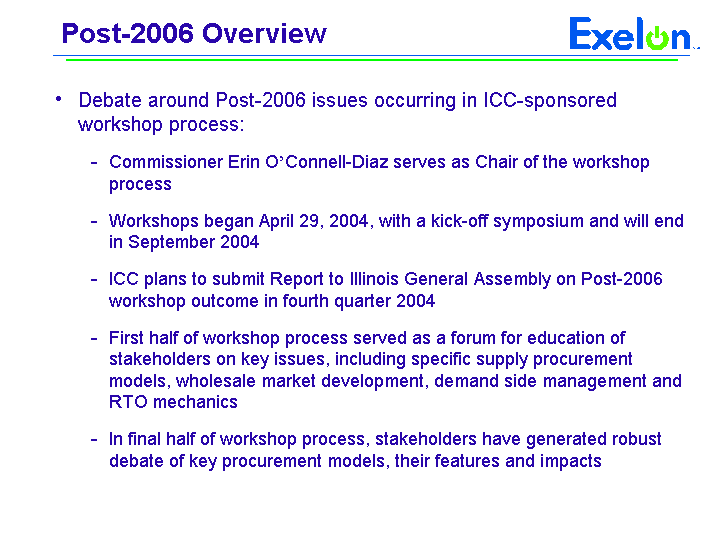
| Debate around Post-2006 issues occurring in ICC-sponsored workshop process: Commissioner Erin O'Connell-Diaz serves as Chair of the workshop process Workshops began April 29, 2004, with a kick-off symposium and will end in September 2004 ICC plans to submit Report to Illinois General Assembly on Post-2006 workshop outcome in fourth quarter 2004 First half of workshop process served as a forum for education of stakeholders on key issues, including specific supply procurement models, wholesale market development, demand side management and RTO mechanics In final half of workshop process, stakeholders have generated robust debate of key procurement models, their features and impacts Post-2006 Overview |
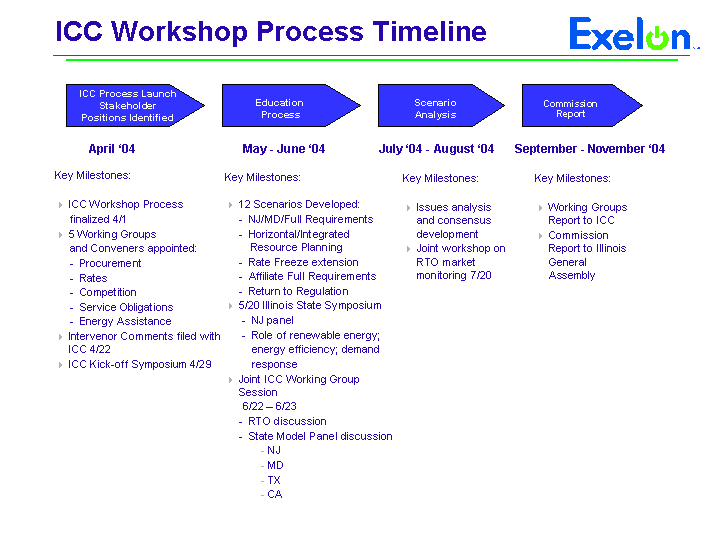
| ICC Workshop Process Timeline Education Process Scenario Analysis ICC Process Launch Stakeholder Positions Identified Key Milestones: ICC Workshop Process finalized 4/1 5 Working Groups and Conveners appointed: - Procurement - Rates - Competition - Service Obligations - Energy Assistance Intervenor Comments filed with ICC 4/22 ICC Kick-off Symposium 4/29 Key Milestones: 12 Scenarios Developed: - NJ/MD/Full Requirements - Horizontal/Integrated Resource Planning - Rate Freeze extension - Affiliate Full Requirements - Return to Regulation 5/20 Illinois State Symposium - NJ panel - Role of renewable energy; energy efficiency; demand response Joint ICC Working Group Session 6/22 - 6/23 - RTO discussion - State Model Panel discussion NJ MD TX CA Key Milestones: Working Groups Report to ICC Commission Report to Illinois General Assembly Key Milestones: Issues analysis and consensus development Joint workshop on RTO market monitoring 7/20 April '04 May - June '04 July '04 - August '04 September - November '04 Commission Report |
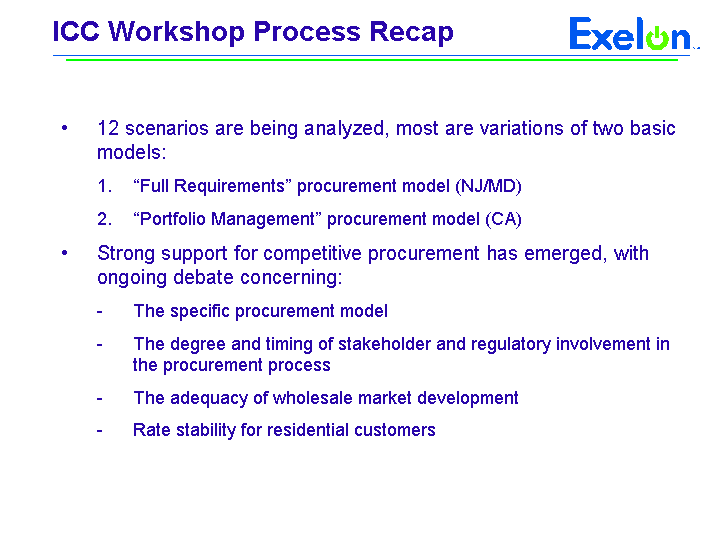
| ICC Workshop Process Recap 12 scenarios are being analyzed, most are variations of two basic models: "Full Requirements" procurement model (NJ/MD) "Portfolio Management" procurement model (CA) Strong support for competitive procurement has emerged, with ongoing debate concerning: The specific procurement model The degree and timing of stakeholder and regulatory involvement in the procurement process The adequacy of wholesale market development Rate stability for residential customers |
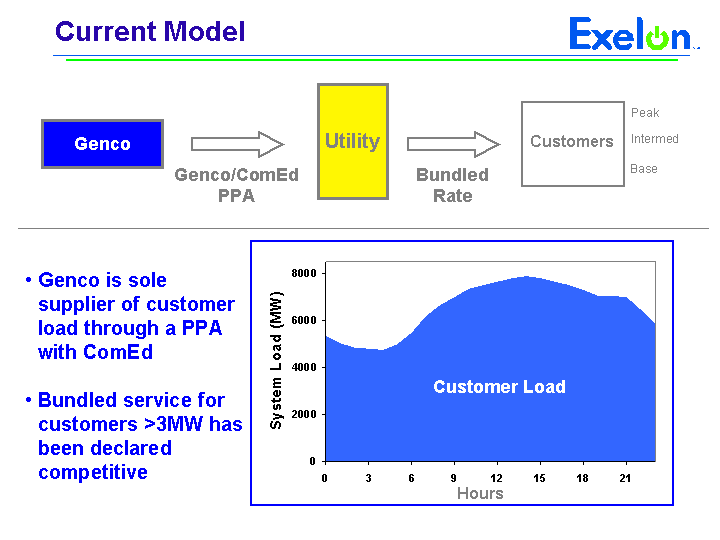
| Current Model Utility Genco Base Intermed Peak Customers Hours Genco is sole supplier of customer load through a PPA with ComEd Bundled service for customers >3MW has been declared competitive Genco/ComEd PPA Bundled Rate Customer Load |
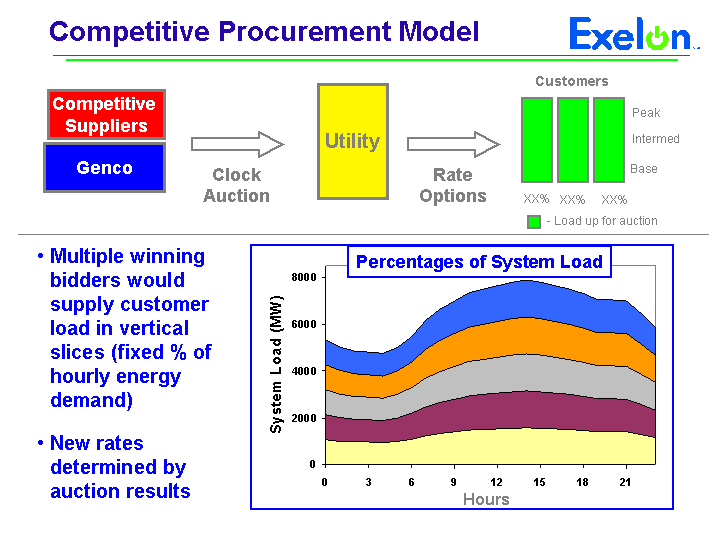
| Competitive Procurement Model Competitive Suppliers Utility Genco Base Intermed Peak Customers - - Load up for auction XX% XX% XX% Hours Percentages of System Load Multiple winning bidders would supply customer load in vertical slices (fixed % of hourly energy demand) New rates determined by auction results Clock Auction Rate Options |
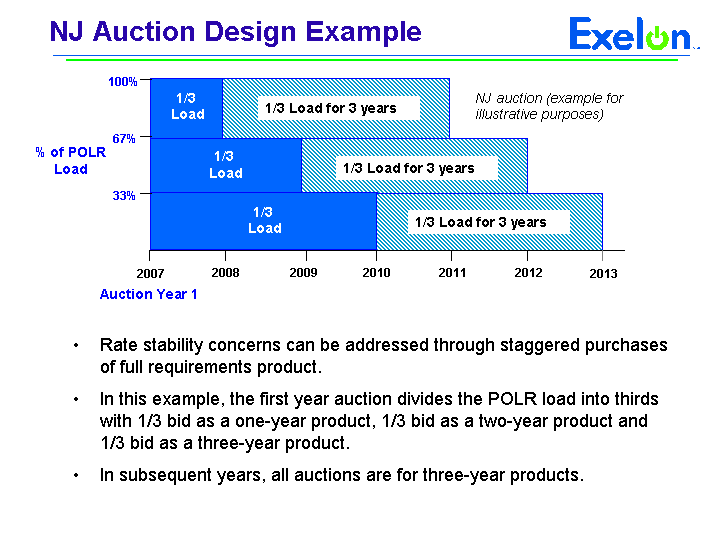
| 2007 2008 2010 2009 2011 33% 67% 100% 2012 2013 Auction Year 1 1/3 Load 1/3 Load for 3 years % of POLR Load 1/3 Load 1/3 Load 1/3 Load for 3 years 1/3 Load for 3 years NJ auction (example for illustrative purposes) Rate stability concerns can be addressed through staggered purchases of full requirements product. In this example, the first year auction divides the POLR load into thirds with 1/3 bid as a one-year product, 1/3 bid as a two-year product and 1/3 bid as a three-year product. In subsequent years, all auctions are for three-year products. NJ Auction Design Example |
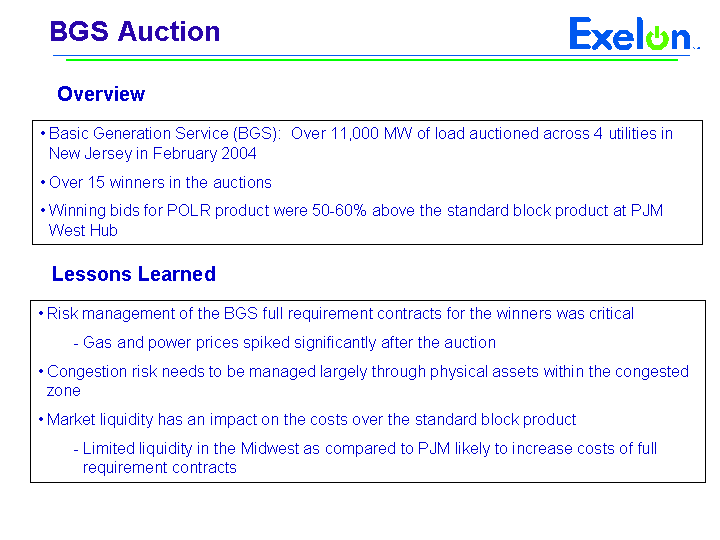
| Basic Generation Service (BGS): Over 11,000 MW of load auctioned across 4 utilities in New Jersey in February 2004 Over 15 winners in the auctions Winning bids for POLR product were 50-60% above the standard block product at PJM West Hub Overview Risk management of the BGS full requirement contracts for the winners was critical - - Gas and power prices spiked significantly after the auction Congestion risk needs to be managed largely through physical assets within the congested zone Market liquidity has an impact on the costs over the standard block product - - Limited liquidity in the Midwest as compared to PJM likely to increase costs of full requirement contracts Lessons Learned BGS Auction |
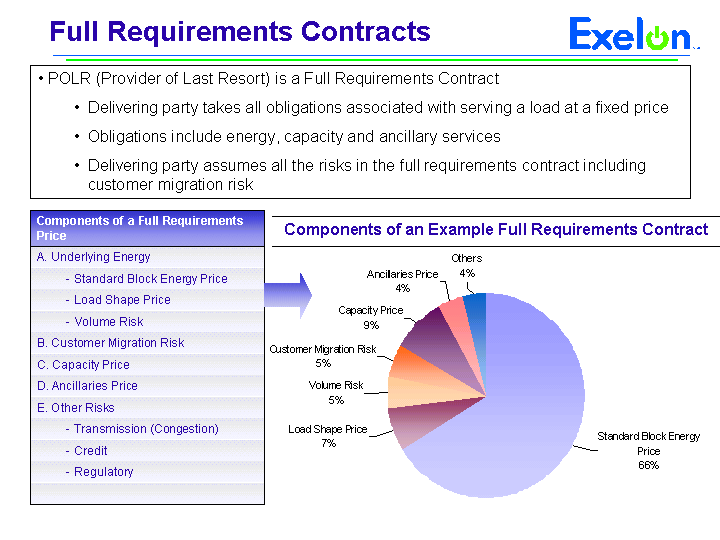
| Full Requirements Contracts Components of a Full Requirements Price A. Underlying Energy - Standard Block Energy Price - Load Shape Price - Volume Risk B. Customer Migration Risk C. Capacity Price D. Ancillaries Price E. Other Risks - Transmission (Congestion) - Credit - Regulatory Components of an Example Full Requirements Contract POLR (Provider of Last Resort) is a Full Requirements Contract Delivering party takes all obligations associated with serving a load at a fixed price Obligations include energy, capacity and ancillary services Delivering party assumes all the risks in the full requirements contract including customer migration risk |
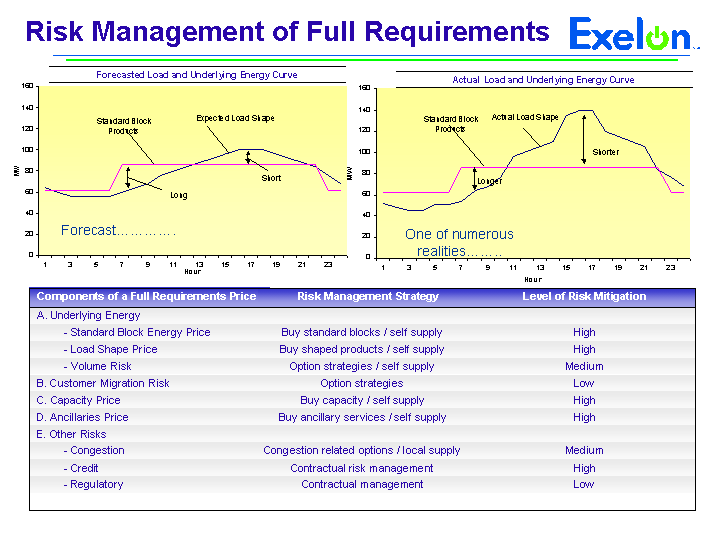
| Risk Management of Full Requirements Forecasted Load and Underlying Energy Curve Actual Load and Underlying Energy Curve Standard Block Products Expected Load Shape Long Short Standard Block Products Actual Load Shape Shorter Longer Forecast............. One of numerous realities........ - Regulatory - Credit - Congestion E. Other Risks D. Ancillaries Price C. Capacity Price B. Customer Migration Risk - Volume Risk - Load Shape Price - Standard Block Energy Price A. Underlying Energy Components of a Full Requirements Price Contractual management Contractual risk management Congestion related options / local supply Buy ancillary services / self supply Buy capacity / self supply Option strategies Option strategies / self supply Buy shaped products / self supply Buy standard blocks / self supply Risk Management Strategy High High Medium Low High High Medium High Low Level of Risk Mitigation |
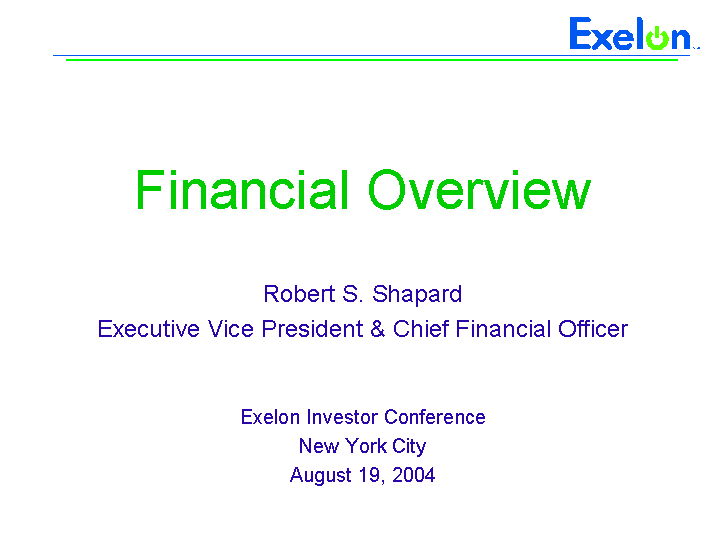
| Financial Overview Robert S. Shapard Executive Vice President & Chief Financial Officer Exelon Investor Conference New York City August 19, 2004 |
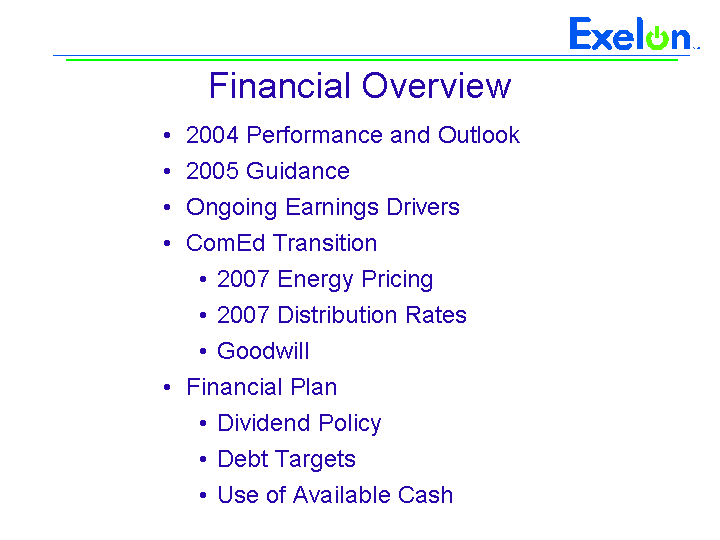
| Financial Overview 2004 Performance and Outlook 2005 Guidance Ongoing Earnings Drivers ComEd Transition 2007 Energy Pricing 2007 Distribution Rates Goodwill Financial Plan Dividend Policy Debt Targets Use of Available Cash |
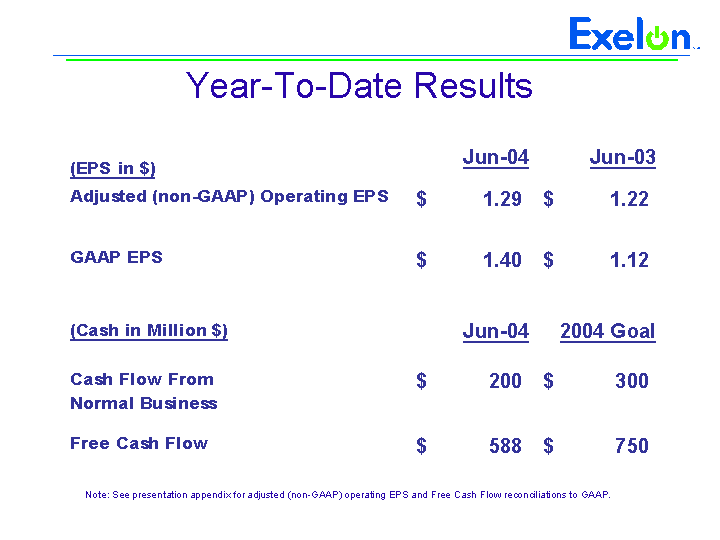
| Year-To-Date Results Note: See presentation appendix for adjusted (non-GAAP) operating EPS and Free Cash Flow reconciliations to GAAP. |
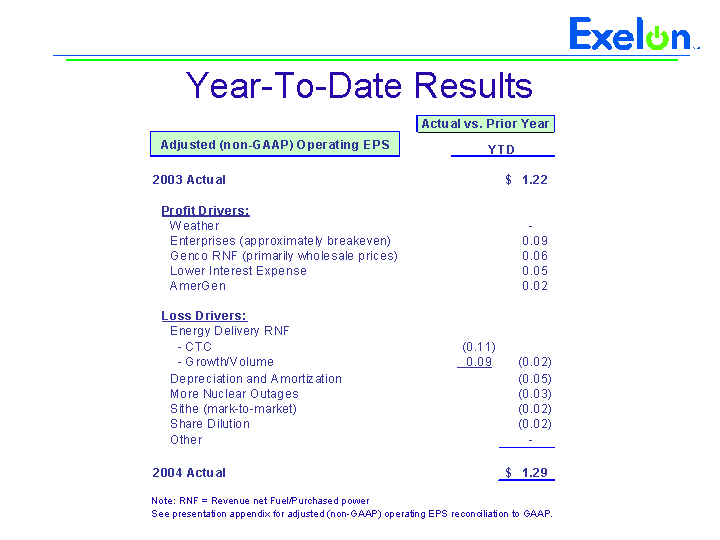
| Year-To-Date Results Note: RNF = Revenue net Fuel/Purchased power See presentation appendix for adjusted (non-GAAP) operating EPS reconciliation to GAAP. |
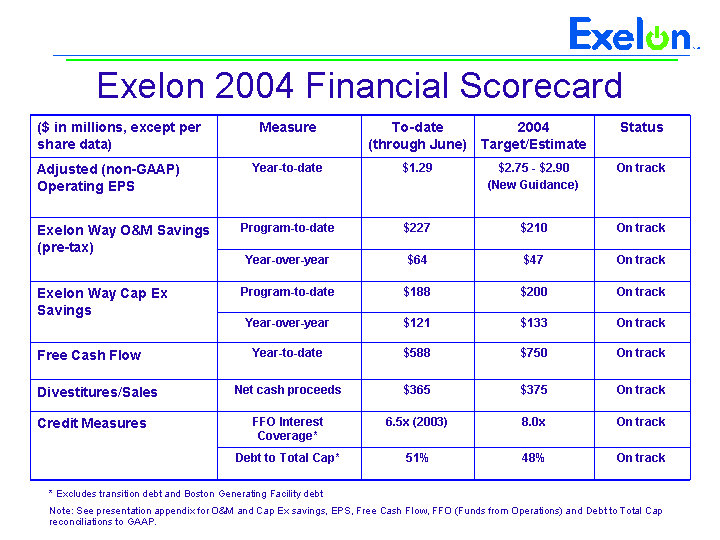
| ($ in millions, except per share data) Measure To-date (through June) 2004 Target/Estimate Status Adjusted (non-GAAP) Operating EPS Year-to-date $1.29 $2.75 - $2.90 (New Guidance) On track Exelon Way O&M Savings (pre-tax) Program-to-date $227 $210 On track Exelon Way O&M Savings (pre-tax) Year-over-year $64 $47 On track Exelon Way Cap Ex Savings Program-to-date $188 $200 On track Exelon Way Cap Ex Savings Year-over-year $121 $133 On track Free Cash Flow Year-to-date $588 $750 On track Divestitures/Sales Net cash proceeds $365 $375 On track Credit Measures FFO Interest Coverage* 6.5x (2003) 8.0x On track Credit Measures Debt to Total Cap* 51% 48% On track * Excludes transition debt and Boston Generating Facility debt Note: See presentation appendix for O&M and Cap Ex savings, EPS, Free Cash Flow, FFO (Funds from Operations) and Debt to Total Cap reconciliations to GAAP. Exelon 2004 Financial Scorecard |
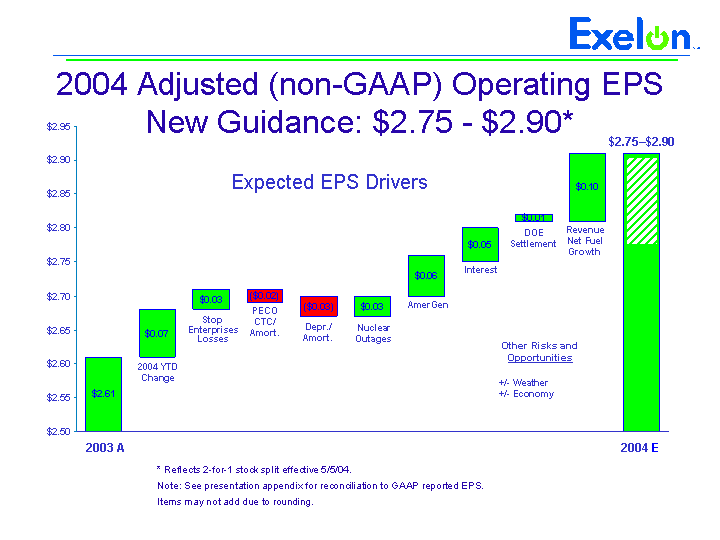
| 2003 A 2004 YTD Enterprises CTC Depr./ Amort. & Outages Nuclear Outages AmerGen Interest DOE Sales Growth 2004 Invisible dataset 0 2.61 2.68 2.69 2.67 2.67 2.7 2.75 2.81 2.81 0 Green 2.61 0.07 0.03 0.02 0.03 0.03 0.06 0.05 0.01 0.1 2.91 2003 A 2004 E Interest PECO CTC/ Amort. Depr./ Amort. Stop Enterprises Losses AmerGen DOE Settlement Revenue Net Fuel Growth Nuclear Outages $2.75-$2.90 Other Risks and Opportunities +/- Weather +/- Economy 2004 YTD Change Expected EPS Drivers 2004 Adjusted (non-GAAP) Operating EPS New Guidance: $2.75 - $2.90* * Reflects 2-for-1 stock split effective 5/5/04. Note: See presentation appendix for reconciliation to GAAP reported EPS. Items may not add due to rounding. |
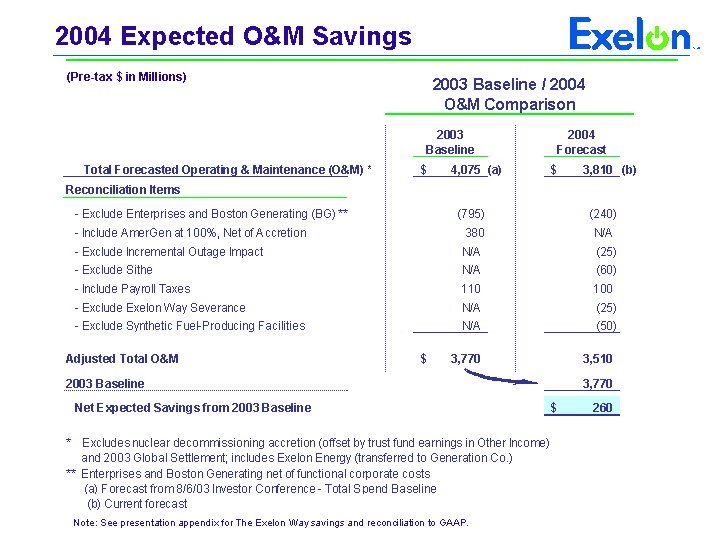
| 2004 Expected O&M Savings (Pre-tax $ in Millions) Note: See presentation appendix for The Exelon Way savings and reconciliation to GAAP. |
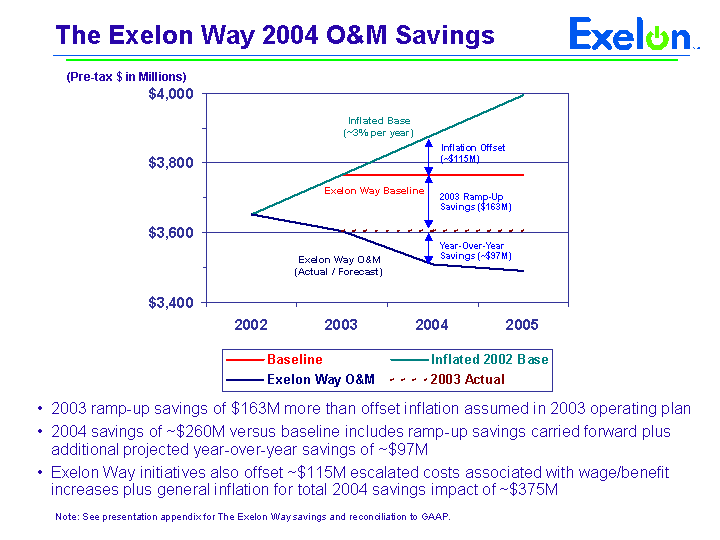
| (Pre-tax $ in Millions) The Exelon Way 2004 O&M Savings 2003 ramp-up savings of $163M more than offset inflation assumed in 2003 operating plan 2004 savings of ~$260M versus baseline includes ramp-up savings carried forward plus additional projected year-over-year savings of ~$97M Exelon Way initiatives also offset ~$115M escalated costs associated with wage/benefit increases plus general inflation for total 2004 savings impact of ~$375M 2002 2003 2004 2005 Baseline 3767 3767 3767 Inflated 2002 Base 3651 3767 3880 3996 Exelon Way O&M 3651 3604 3510 3490 2003 Actual 3604 3604 3604 Exelon Way Baseline 2003 Ramp-Up Savings ($163M) Inflation Offset (~$115M) Year-Over-Year Savings (~$97M) Exelon Way O&M (Actual / Forecast) Inflated Base (~3% per year) Note: See presentation appendix for The Exelon Way savings and reconciliation to GAAP. |
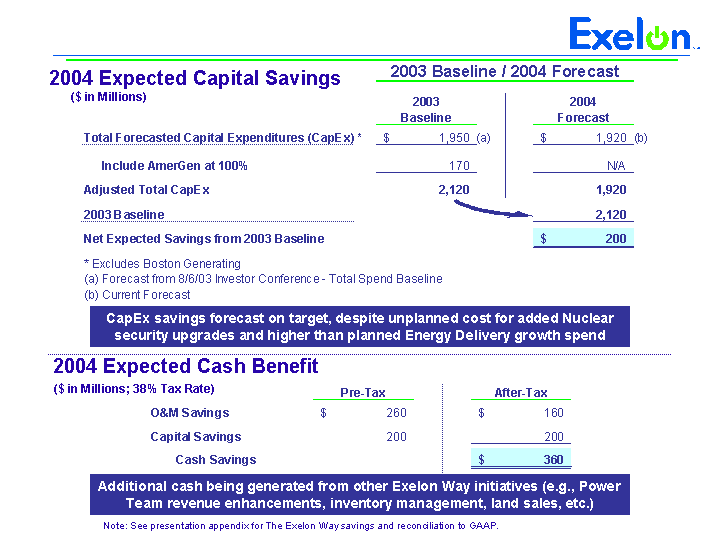
| 2004 Expected Capital Savings 2004 Expected Cash Benefit CapEx savings forecast on target, despite unplanned cost for added Nuclear security upgrades and higher than planned Energy Delivery growth spend ($ in Millions) ($ in Millions; 38% Tax Rate) Additional cash being generated from other Exelon Way initiatives (e.g., Power Team revenue enhancements, inventory management, land sales, etc.) Note: See presentation appendix for The Exelon Way savings and reconciliation to GAAP. |
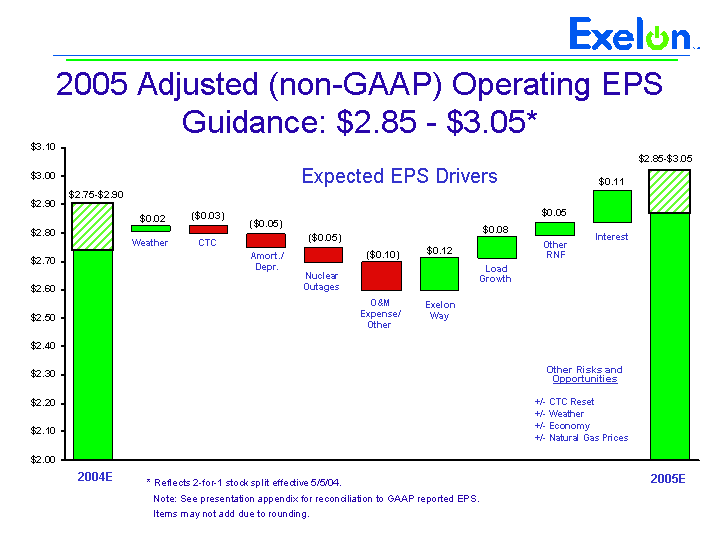
| 2004 Guidance Weather ComEd CTC Amort. / Depr. Nuclear Outages /Fuel O&M + Pension + All Other Exelon Way Load Growth Other RNF Interest 2005 Guidance Invisible dataset 0 2.807217509 2.796245631 2.746768665 2.697 2.597 2.597 2.71 2.79 2.837 0 Green 2.807217509 0.016342461 0.027314339 0.049476966 0.05 0.100410312 0.11678395 0.078531763 0.045085597 0.113539044 2.924126675 2004E 2005E Interest O&M Expense/ Other CTC Exelon Way Expected EPS Drivers Amort./ Depr. 2005 Adjusted (non-GAAP) Operating EPS Guidance: $2.85 - $3.05* * Reflects 2-for-1 stock split effective 5/5/04. Note: See presentation appendix for reconciliation to GAAP reported EPS. Items may not add due to rounding. Nuclear Outages Weather Load Growth Other RNF Other Risks and Opportunities +/- CTC Reset +/- Weather +/- Economy +/- Natural Gas Prices |
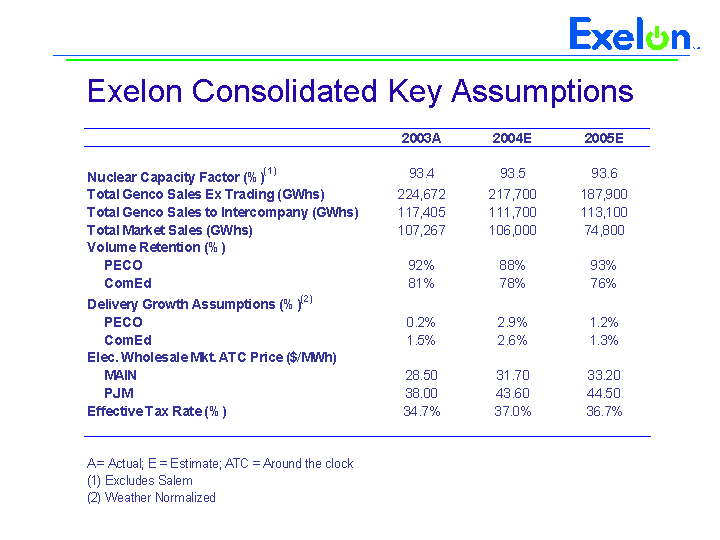
| Exelon Consolidated Key Assumptions |
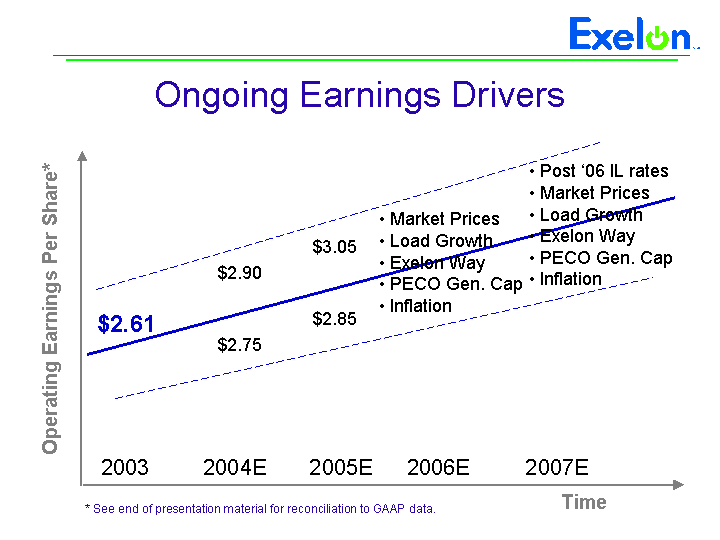
| Ongoing Earnings Drivers Operating Earnings Per Share* Time 2003 2004E 2005E 2006E 2007E * See end of presentation material for reconciliation to GAAP data. $2.90 $2.75 $3.05 $2.85 $2.61 Market Prices Load Growth Exelon Way PECO Gen. Cap Inflation Post '06 IL rates Market Prices Load Growth Exelon Way PECO Gen. Cap Inflation |
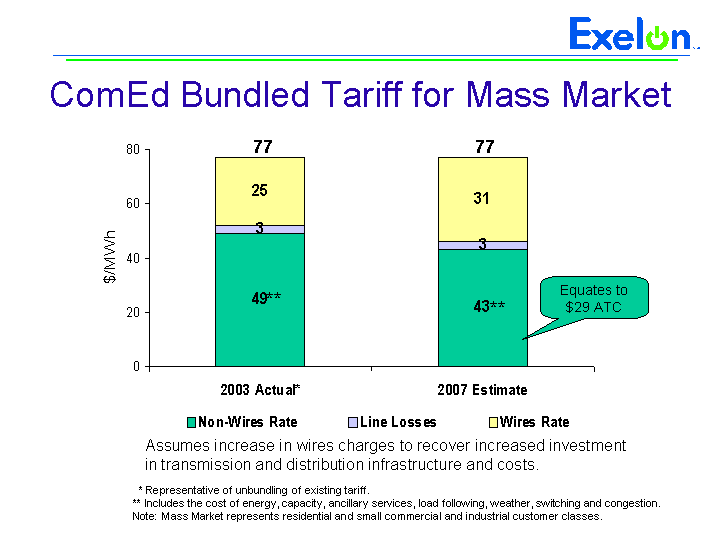
| ComEd Bundled Tariff for Mass Market 2003 Actual* 2007 Estimate RES SCI LCI LCI (< 3 MW) Non-Wires Rate 49 43 49.9 49.9 48.9 28 Line Losses 3 3 Wires Rate 25 31 35.1 15.1 10.1 3 77 77 Assumes increase in wires charges to recover increased investment in transmission and distribution infrastructure and costs. * Representative of unbundling of existing tariff. ** Includes the cost of energy, capacity, ancillary services, load following, weather, switching and congestion. Note: Mass Market represents residential and small commercial and industrial customer classes. ** ** Equates to $29 ATC |
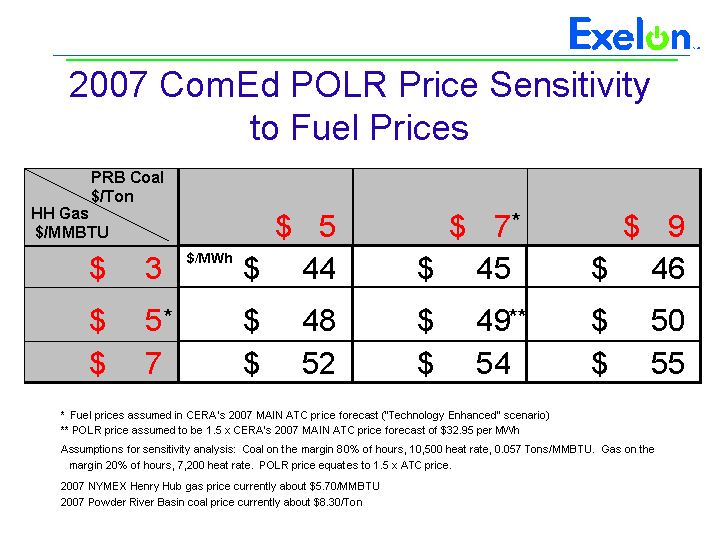
| 2007 ComEd POLR Price Sensitivity to Fuel Prices PRB Coal $/Ton HH Gas $/MMBTU * Fuel prices assumed in CERA's 2007 MAIN ATC price forecast ("Technology Enhanced" scenario) ** POLR price assumed to be 1.5 x CERA's 2007 MAIN ATC price forecast of $32.95 per MWh Assumptions for sensitivity analysis: Coal on the margin 80% of hours, 10,500 heat rate, 0.057 Tons/MMBTU. Gas on the margin 20% of hours, 7,200 heat rate. POLR price equates to 1.5 x ATC price. 2007 NYMEX Henry Hub gas price currently about $5.70/MMBTU 2007 Powder River Basin coal price currently about $8.30/Ton * * ** $/MWh |
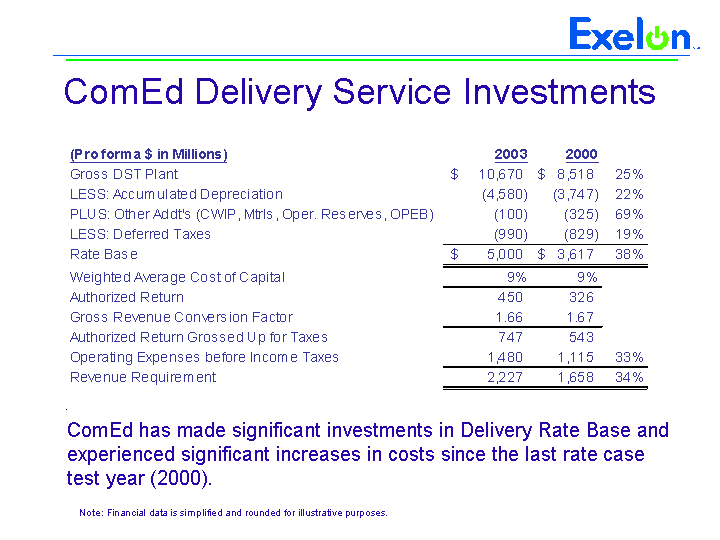
| ComEd Delivery Service Investments ComEd has made significant investments in Delivery Rate Base and experienced significant increases in costs since the last rate case test year (2000). Note: Financial data is simplified and rounded for illustrative purposes. |
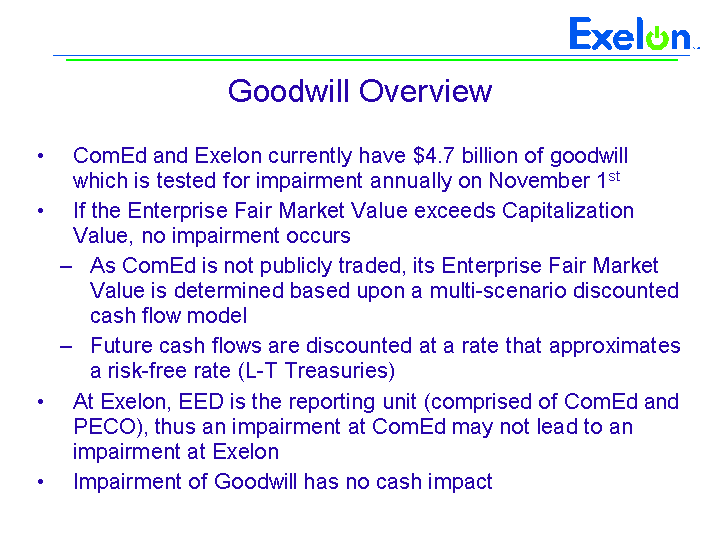
| Goodwill Overview ComEd and Exelon currently have $4.7 billion of goodwill which is tested for impairment annually on November 1st If the Enterprise Fair Market Value exceeds Capitalization Value, no impairment occurs As ComEd is not publicly traded, its Enterprise Fair Market Value is determined based upon a multi-scenario discounted cash flow model Future cash flows are discounted at a rate that approximates a risk-free rate (L-T Treasuries) At Exelon, EED is the reporting unit (comprised of ComEd and PECO), thus an impairment at ComEd may not lead to an impairment at Exelon Impairment of Goodwill has no cash impact |
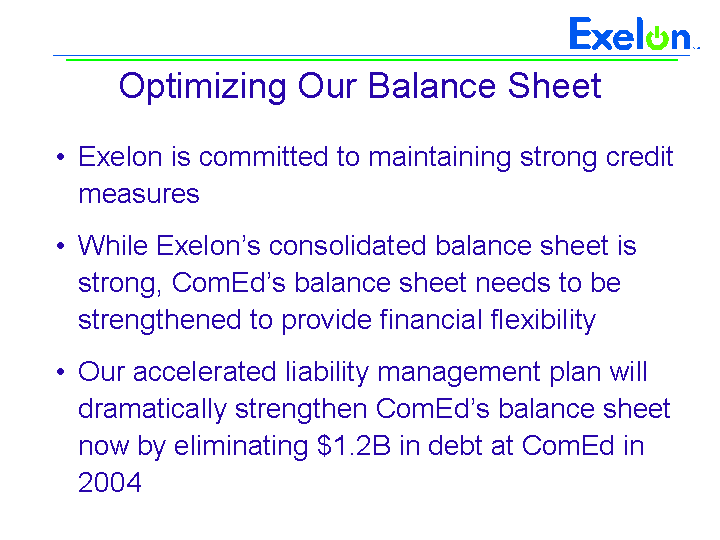
| Optimizing Our Balance Sheet Exelon is committed to maintaining strong credit measures While Exelon's consolidated balance sheet is strong, ComEd's balance sheet needs to be strengthened to provide financial flexibility Our accelerated liability management plan will dramatically strengthen ComEd's balance sheet now by eliminating $1.2B in debt at ComEd in 2004 |
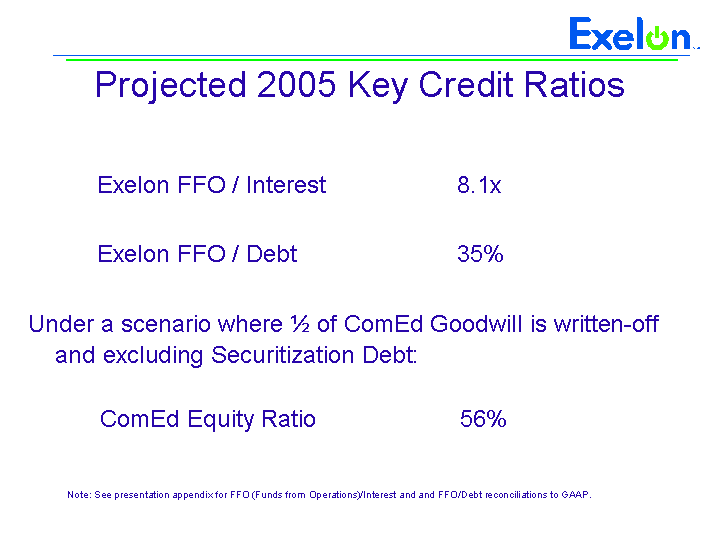
| Projected 2005 Key Credit Ratios Exelon FFO / Interest 8.1x Exelon FFO / Debt 35% Under a scenario where 1/2 of ComEd Goodwill is written-off and excluding Securitization Debt: ComEd Equity Ratio 56% Note: See presentation appendix for FFO (Funds from Operations)/Interest and and FFO/Debt reconciliations to GAAP. |
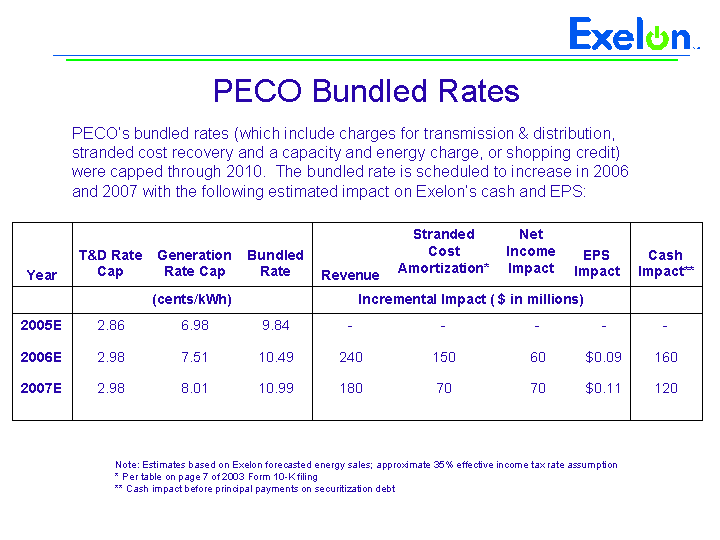
| PECO Bundled Rates PECO's bundled rates (which include charges for transmission & distribution, stranded cost recovery and a capacity and energy charge, or shopping credit) were capped through 2010. The bundled rate is scheduled to increase in 2006 and 2007 with the following estimated impact on Exelon's cash and EPS: Note: Estimates based on Exelon forecasted energy sales; approximate 35% effective income tax rate assumption * Per table on page 7 of 2003 Form 10-K filing ** Cash impact before principal payments on securitization debt Year T&D Rate Cap Generation Rate Cap Bundled Rate Revenue Stranded Cost Amortization* Net Income Impact EPS Impact EPS Impact Cash Impact** (cents/kWh) (cents/kWh) (cents/kWh) Incremental Impact ( $ in millions) Incremental Impact ( $ in millions) Incremental Impact ( $ in millions) Incremental Impact ( $ in millions) Incremental Impact ( $ in millions) 2005E 2.86 6.98 9.84 - - - - - - 2006E 2.98 7.51 10.49 240 150 60 60 $0.09 160 2007E 2.98 8.01 10.99 180 70 70 70 $0.11 120 |
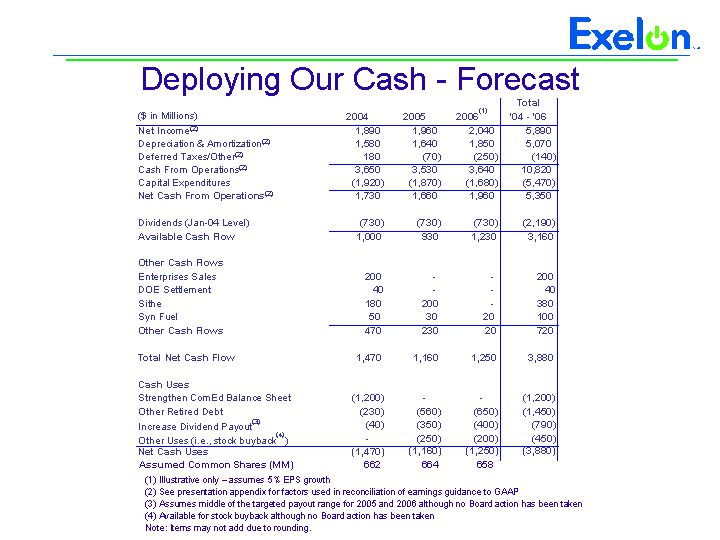
| Deploying Our Cash - Forecast (1) Illustrative only - assumes 5% EPS growth (2) See presentation appendix for factors used in reconciliation of earnings guidance to GAAP (3) Assumes middle of the targeted payout range for 2005 and 2006 although no Board action has been taken (4) Available for stock buyback although no Board action has been taken Note: Items may not add due to rounding. ($ in Millions) 2004 2005 2006 (1) Total '04 - '06 Net Income(2) 1,890 1,960 2,040 5,890 Depreciation & Amortization(2) 1,580 1,640 1,850 5,070 Deferred Taxes/Other(2) 180 (70) (250) (140) Cash From Operations(2) 3,650 3,530 3,640 10,820 Capital Expenditures (1,920) (1,870) (1,680) (5,470) Net Cash From Operations(2) 1,730 1,660 1,960 5,350 Dividends (Jan-04 Level) (730) (730) (730) (2,190) Available Cash Flow 1,000 930 1,230 3,160 Other Cash Flows Enterprises Sales 200 - - 200 DOE Settlement 40 - - 40 Sithe 180 200 - 380 Syn Fuel 50 30 20 100 Other Cash Flows 470 230 20 720 Total Net Cash Flow 1,470 1,160 1,250 3,880 Cash Uses Strengthen ComEd Balance Sheet (1,200) - - - - (1,200) Other Retired Debt (230) (560) (650) (1,450) Increase Dividend Payout (3) (40) (350) (400) (790) Other Uses (i.e., stock buyback (4) ) - - (250) (200) (450) Net Cash Uses (1,470) (1,160) (1,250) (3,880) Assumed Common Shares (MM) 662 664 658 |
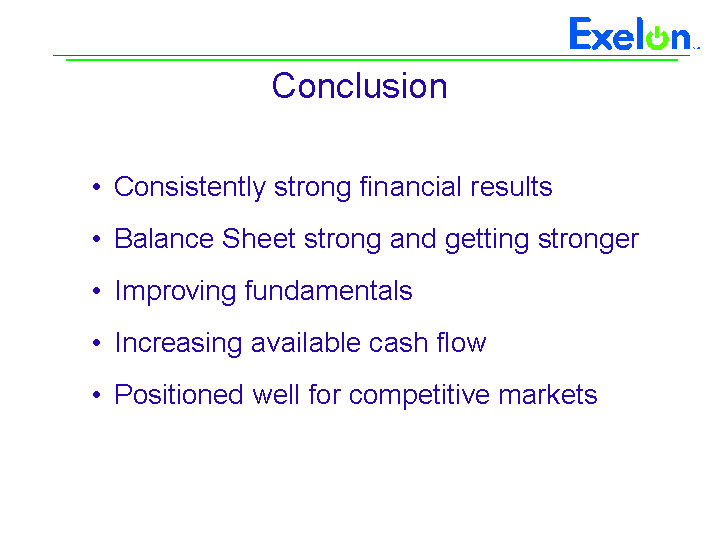
| Conclusion Consistently strong financial results Balance Sheet strong and getting stronger Improving fundamentals Increasing available cash flow Positioned well for competitive markets |
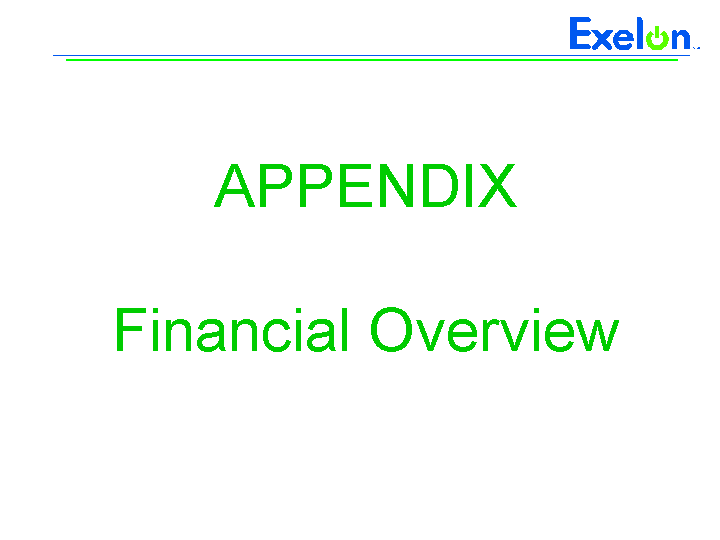
| APPENDIX Financial Overview |
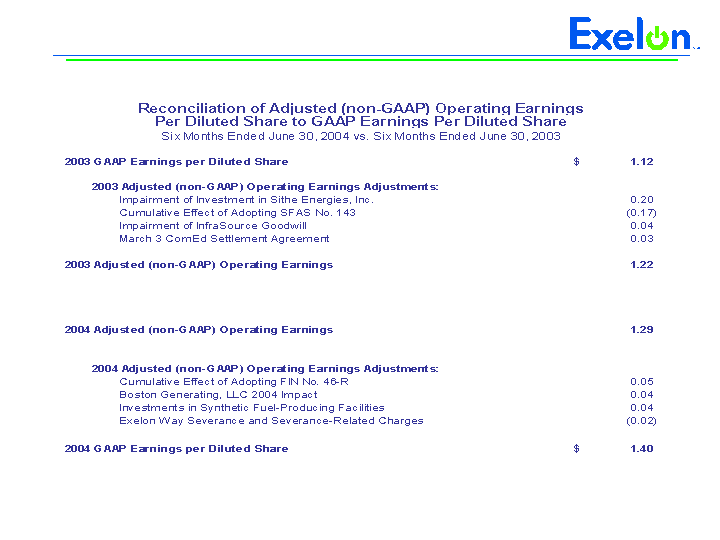
| Reconciliation of Adjusted (non-GAAP) Operating Earnings Per Diluted Share to GAAP Earnings Per Diluted Share Six Months Ended June 30, 2004 vs. Six Months Ended June 30, 2003 2003 GAAP Earnings per Diluted Share $ 1.12 2003 Adjusted (non-GAAP) Operating Earnings Adjustments: Impairment of Investment in Sithe Energies, Inc. 0.20 Cumulative Effect of Adopting SFAS No. 143 (0.17) Impairment of InfraSource Goodwill 0.04 March 3 ComEd Settlement Agreement 0.03 2003 Adjusted (non-GAAP) Operating Earnings 1.22 2004 Adjusted (non-GAAP) Operating Earnings 1.29 2004 Adjusted (non-GAAP) Operating Earnings Adjustments: Cumulative Effect of Adopting FIN No. 46-R 0.05 Boston Generating, LLC 2004 Impact 0.04 Investments in Synthetic Fuel-Producing Facilities 0.04 Exelon Way Severance and Severance-Related Charges (0.02) 2004 GAAP Earnings per Diluted Share $ 1.40 |
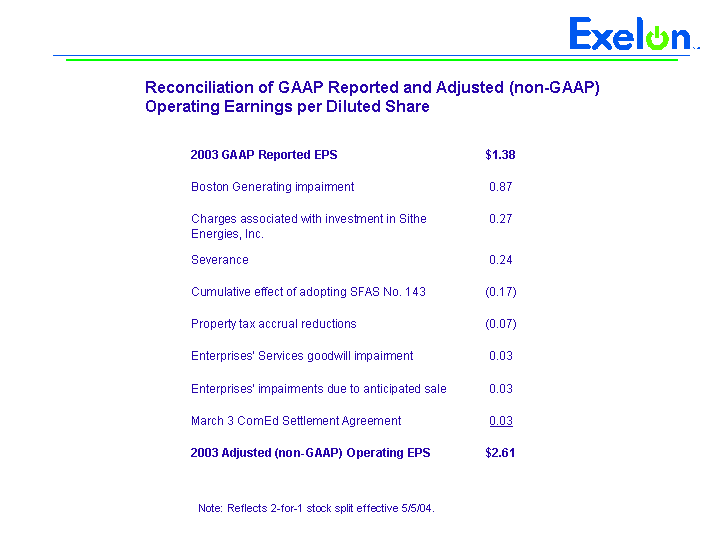
| Reconciliation of GAAP Reported and Adjusted (non-GAAP) Operating Earnings per Diluted Share Note: Reflects 2-for-1 stock split effective 5/5/04. |
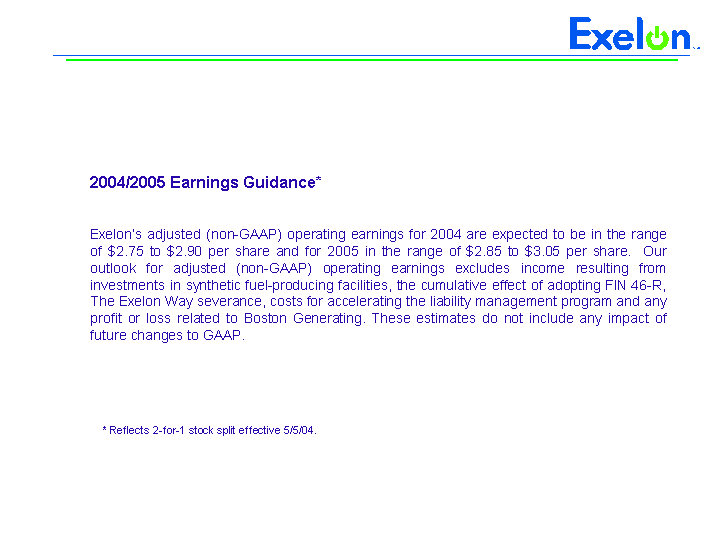
| 2004/2005 Earnings Guidance* Exelon's adjusted (non-GAAP) operating earnings for 2004 are expected to be in the range of $2.75 to $2.90 per share and for 2005 in the range of $2.85 to $3.05 per share. Our outlook for adjusted (non-GAAP) operating earnings excludes income resulting from investments in synthetic fuel-producing facilities, the cumulative effect of adopting FIN 46-R, The Exelon Way severance, costs for accelerating the liability management program and any profit or loss related to Boston Generating. These estimates do not include any impact of future changes to GAAP. * Reflects 2-for-1 stock split effective 5/5/04. |

| 2003 Pre-tax O&M | ||||||||
| ($ in millions) | Ramp-up Savings | |||||||
| 2002 | 2003 | |||||||
GAAP Operating and Maintenance (O&M) | $ | 4,345 | $ | 4,587 | ||||
Operating Adjustments: | ||||||||
| March 2003 ComEd Settlement Agreement | — | (41 | ) | |||||
| Severance | (10 | ) | (256 | ) | ||||
| Enterprises goodwill impairment and impairments due to anticipated sales | — | (53 | ) | |||||
Operating O&M | 4,335 | 4,237 | ||||||
Exelon Way O&M Adjustments: | ||||||||
| Remove Enterprises and Boston Generating (BG) (1) | (1,212 | ) | (903 | ) | ||||
| Add incremental impact of Texas Plants | 10 | — | ||||||
| Remove nuclear decommissioning accretion expense (2) | — | (197 | ) | |||||
| Add 2002 incremental impact of Exelon New England | 50 | — | ||||||
| Normalize incremental impact of nuclear outages | (24 | ) | — | |||||
| Add AmerGen, net of decommissioning accretion (3) | 412 | 393 | ||||||
| Add Payroll Taxes (4) | 95 | 91 | ||||||
Exelon Way O&M | $ | 3,666 | $ | 3,621 | ||||
Exelon Way O&M Savings: | ||||||||
| Difference between 2002 and 2003 Exelon Way O&M | $ | 45 | ||||||
| 2003 inflationary impact (5) | 107 | |||||||
| Pension and post-retirement increase (6) | 103 | |||||||
Calculated 2003 Savings | $ | 255 | ||||||
| Exclude savings from prior cost management initiatives (e.g., CMI) | (92 | ) | ||||||
Exelon Way O&M Savings — Pre-tax | $ | 163 | ||||||
After-tax O&M Savings (7) | $ | 101 | ||||||
| 2003 Cap Ex | ||||||||
| Ramp-up Savings | ||||||||
| 2002 | 2003 | |||||||
GAAP Capital Expenditures (CapEx) (A) | $ | 2,150 | $ | 1,862 | ||||
Adjustments: | ||||||||
| Exclude net impact of Boston Generating (A) | — | 20 | ||||||
| Include AmerGen | 155 | 171 | ||||||
Adjusted CapEx | $ | 2,305 | $ | 2,053 | ||||
Year-over-year CapEx Savings | $ | 252 | ||||||
Exelon Way CapEx Savings: | ||||||||
| Difference between 2002 and 2003 Exelon Way CapEx | $ | 252 | ||||||
| 2003 inflationary impact (B) | 69 | |||||||
Calculated 2003 Savings | $ | 321 | ||||||
| Exclude savings from prior cost management initiatives (e.g., CMI) | (254 | ) | ||||||
Exelon Way Savings - 2003 Ramp-up | $ | 67 | ||||||
| (A) Net of proceeds from liquidated damages for 2003 | ||||||||
| (B) Inflation assumed at 3% | ||||||||
Total Ramp-up Cash Savings | ||||||||
| After-tax O&M | $ | 101 | ||||||
| CapEx | 67 | |||||||
Total Exelon Way Cash Savings | $ | 168 | ||||||
| (1) | O&M is net of intercompany impact and excludes corporate business services costs that remain; Enterprises excludes Exelon Energy | |||
| (2) | Accretion expense is a non-cash expense related to nuclear decommissioning and is not included in Exelon Way expenditures | |||
| (3) | Normalized to 100% of AmerGen in 2002 and 2003; in 2002 and 2003, AmerGen was included in Equity in Earnings of Unconsolidated Affiliates | |||
| (4) | Includes AmerGen and excludes Enterprises | |||
| (5) | 2002 base excluding pension and post-retirement expenses of $103m, inflated at 3% | |||
| (6) | Pension and post-retirement expense increase | |||
| (7) | Tax rate is 38% | |||

| Pre-tax O&M | ||||||||
| ($ in millions) | June YTD Savings | |||||||
| 2004 | 2003 | |||||||
GAAP Operating and Maintenance Expense (O&M) | $ | 2,165 | $ | 2,212 | ||||
Operating Adjustments: | ||||||||
| March 3 ComEd Global Settlement Agreement | — | (41 | ) | |||||
| Boston Generating (BG) | (57 | ) | — | |||||
| Investments in Synthetic Fuel Producing Facilities | (48 | ) | — | |||||
| Exelon Way Severance and Severance-related Charges | (22 | ) | — | |||||
| Impairment of Exelon Enterprises’ InfraSource Investment | — | (48 | ) | |||||
Operating O&M | 2,038 | 2,123 | ||||||
Exelon Way O&M Adjustments: | ||||||||
| Remove Net Enterprises and BG (1) | (161 | ) | (473 | ) | ||||
| Remove Nuclear Decommissioning Accretion Expense (2) | (127 | ) | (117 | ) | ||||
| Remove 2004 Incremental Impact of Sithe | (23 | ) | — | |||||
| Add AmerGen, net of Accretion and Severance (3) | — | 193 | ||||||
| Normalize Incremental Impact of Nuclear Outages | (63 | ) | — | |||||
| Add Payroll Taxes (4) | 54 | 56 | ||||||
Exelon Way O&M | $ | 1,718 | $ | 1,782 | ||||
Year-over-Year Exelon Way O&M Savings | $ | 64 | ||||||
| Program-to-Date O&M Savings | Pre-tax | After-tax (5) | ||||||
| 2003 Ramp-up | $ | 163 | $ | 101 | ||||
| 2004 June YTD | 64 | 40 | ||||||
Total Exelon Way O&M Savings | $ | 227 | $ | 141 | ||||
| CapEx | ||||||||
| June YTD Savings | ||||||||
| 2004 | 2003 | |||||||
GAAP Capital Expenditures (CapEx) | $ | 844 | $ | 1,019 | ||||
Adjustments: | ||||||||
| Include AmerGen CapEx | — | 33 | ||||||
| Exclude BG CapEx (incl. 2004 credit) | 7 | (80 | ) | |||||
Adjusted CapEx | $ | 851 | $ | 972 | ||||
Year-over-Year CapEx Savings | $ | 121 | ||||||
Program-to-Date Exelon Way CapEx Savings: | ||||||||
| 2003 Ramp-up | $ | 67 | ||||||
| 2004 June YTD | 121 | |||||||
Total Exelon Way CapEx Savings | $ | 188 | ||||||
Total YTD Cash Savings thru June 2004 | ||||||||
| After-tax O&M | $ | 40 | ||||||
| CapEx | 121 | |||||||
Total Exelon Way Cash Savings | $ | 161 | ||||||
Total Program-to-Date Cash Savings | ||||||||
| After-tax O&M | $ | 141 | ||||||
| CapEx | 188 | |||||||
Total Exelon Way Cash Savings | $ | 329 | ||||||
| (1) | O&M is net of intercompany impact and excludes corporate business services costs that remain. Enterprises excludes Exelon Energy in 2003; in 2004 Exelon Energy is included in Generation. | |||
| (2) | Accretion expense is a non-cash expense related to nuclear decommissioning and is not included in Exelon Way expenditures | |||
| (3) | Normalize to 100% in 2003; in 2003, AmerGen was included in Equity in Earnings of Unconsolidated Affiliates | |||
| (4) | Includes AmerGen and excludes Enterprises | |||
| (5) | Tax rate is 38% | |||
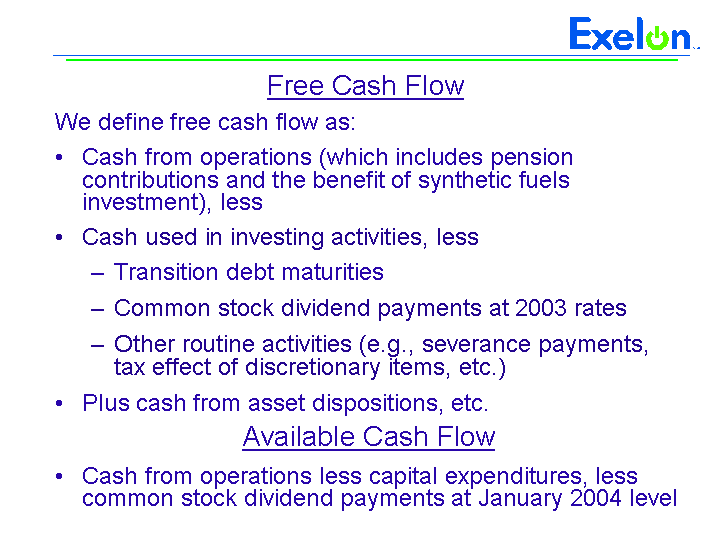
| Free Cash Flow We define free cash flow as: Cash from operations (which includes pension contributions and the benefit of synthetic fuels investment), less Cash used in investing activities, less Transition debt maturities Common stock dividend payments at 2003 rates Other routine activities (e.g., severance payments, tax effect of discretionary items, etc.) Plus cash from asset dispositions, etc. Available Cash Flow Cash from operations less capital expenditures, less common stock dividend payments at January 2004 level |
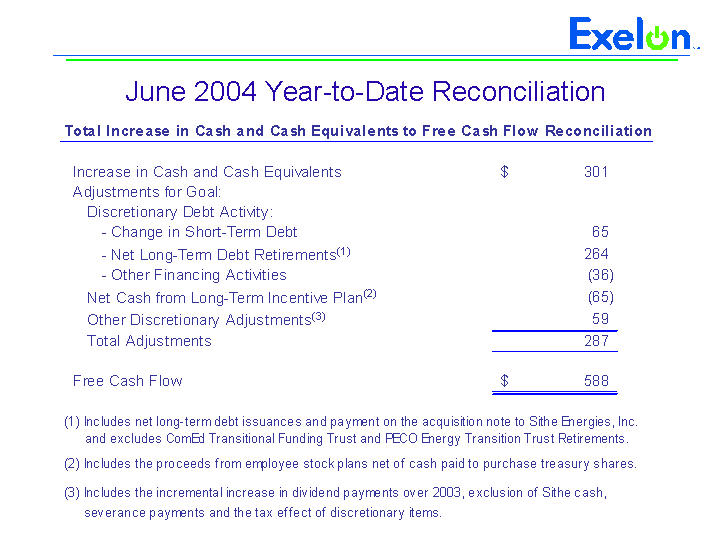
| June 2004 Year-to-Date Reconciliation |
FFO Calculation and Ratios | ||
| Net Income | ||
| Add back non-cash items: | ||
| + Depreciation, amortization (including nucl fuel amortization), AFUDC/Cap Int | ||
| + Change in Deferred Taxes | ||
| + Gain on Sale and Extraordinary Items | ||
| + Trust-Preferred Interest Expense | ||
| - Transition Bond Principal Paydown | ||
| FFO | ||
FFO Interest Coverage | ||
FFO + Adjusted Interest | ||
Adjusted Interest | ||
| Net Interest Expense (Before AFUDC & Cap Interest) | ||
| - Trust-Preferred Interest Expense | ||
| - Transition Bond Interest Expense | ||
| + 10% of PV of Operating Leases | ||
| Adjusted Interest | ||
FFO Debt Coverage | ||
FFO | ||
Adjusted Average Debt (1) | ||
| Debt: | ||
| LTD | ||
| STD | ||
| - Transition Bond Principal Balance | ||
| Add debt equivalents: | ||
| + A/R Financing | ||
| + PV of Operating Leases | ||
| Adjusted Debt | ||
| (1) Use average of prior year and current year adjusted debt balance | ||
Debt to Total Cap | ||
Adjusted Book Debt | ||
Total Adjusted Capitalization | ||
| Debt: | ||
| LTD | ||
| STD | ||
| - Transition Bond Principal Balance | ||
| Adjusted Book Debt | ||
| Capitalization: | ||
| Total Shareholders’ Equity | ||
| Preferred Securities of Subsidiaries | ||
| Adjusted Book Debt | ||
| Total Adjusted Capitalization | ||
| Note: FFO and Debt related to non-recourse debt are excluded from the calculations. |
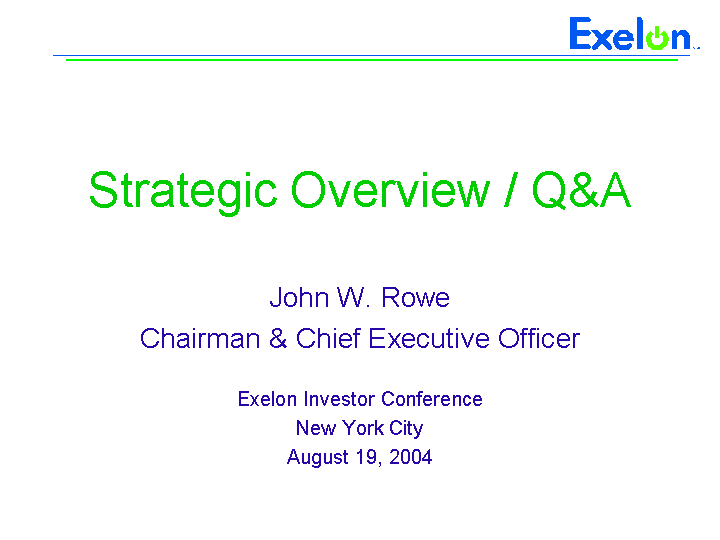
| Strategic Overview / Q&A John W. Rowe Chairman & Chief Executive Officer Exelon Investor Conference New York City August 19, 2004 |
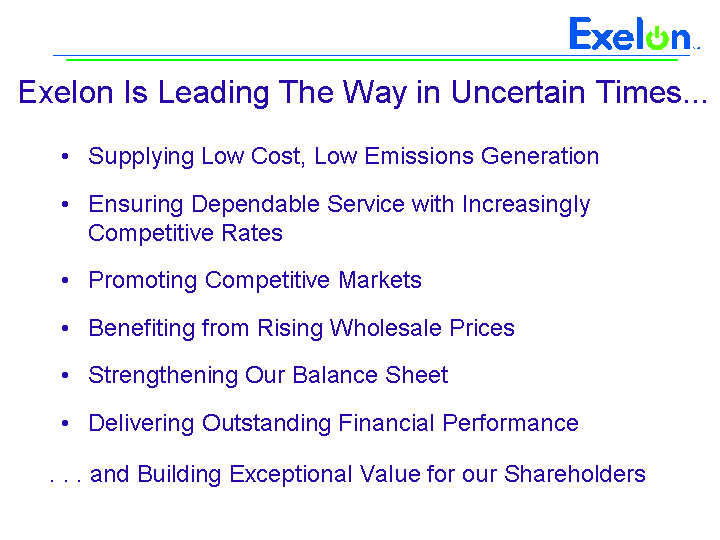
| Supplying Low Cost, Low Emissions Generation Ensuring Dependable Service with Increasingly Competitive Rates Promoting Competitive Markets Benefiting from Rising Wholesale Prices Strengthening Our Balance Sheet Delivering Outstanding Financial Performance Exelon Is Leading The Way in Uncertain Times... .. . . and Building Exceptional Value for our Shareholders |

| Additional Information |
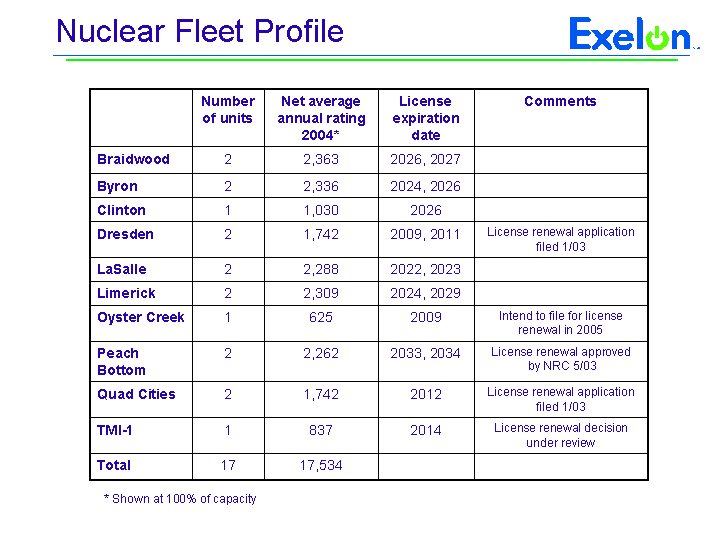
| Nuclear Fleet Profile Number of units Net average annual rating 2004* License expiration date Comments Braidwood 2 2,363 2026, 2027 Byron 2 2,336 2024, 2026 Clinton 1 1,030 2026 Dresden 2 1,742 2009, 2011 License renewal application filed 1/03 LaSalle 2 2,288 2022, 2023 Limerick 2 2,309 2024, 2029 Oyster Creek 1 625 2009 Intend to file for license renewal in 2005 Peach Bottom 2 2,262 2033, 2034 License renewal approved by NRC 5/03 Quad Cities 2 1,742 2012 License renewal application filed 1/03 TMI-1 1 837 2014 License renewal decision under review Total 17 17,534 * Shown at 100% of capacity |
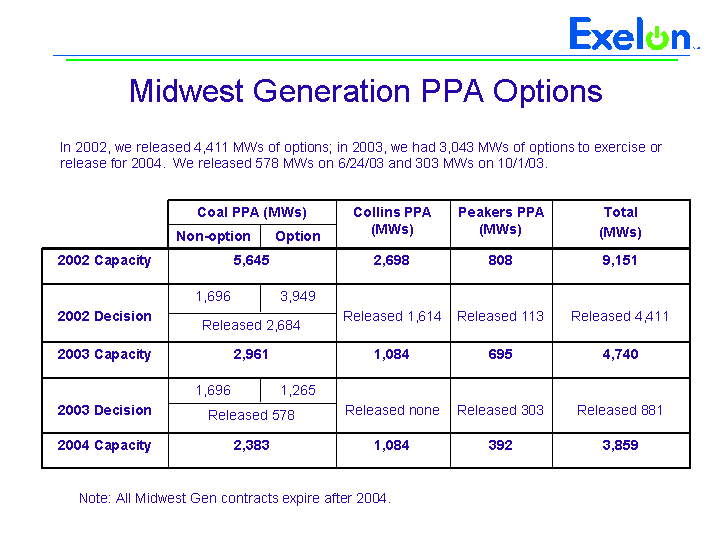
| Midwest Generation PPA Options In 2002, we released 4,411 MWs of options; in 2003, we had 3,043 MWs of options to exercise or release for 2004. We released 578 MWs on 6/24/03 and 303 MWs on 10/1/03. Note: All Midwest Gen contracts expire after 2004. Coal PPA (MWs) Coal PPA (MWs) Collins PPA (MWs) Peakers PPA (MWs) Total (MWs) Non-option Option Collins PPA (MWs) Peakers PPA (MWs) Total (MWs) 2002 Capacity 5,645 5,645 2,698 808 9,151 2002 Decision 1,696 3,949 Released 1,614 Released 113 Released 4,411 2002 Decision Released 2,684 Released 2,684 Released 1,614 Released 113 Released 4,411 2003 Capacity 2,961 2,961 1,084 695 4,740 2003 Decision 1,696 1,265 Released none Released 303 Released 881 2003 Decision Released 578 Released 578 Released none Released 303 Released 881 2004 Capacity 2,383 2,383 1,084 392 3,859 |
PECO ENERGY
Restructuring Settlement
This summary of the major elements of the 1998 settlement reflects amendments made in 2000 following announcement of the PECO Unicom merger.
| • | Recovery of $5.26 billion of stranded costs over a 12-year transition period beginning January 1, 1999 and ending December 31, 2010, with a return of 10.75 percent. |
| • | Rate caps will vary over the transition period. (See Table on Page 2.) |
| • | On January 1, 1999 PECO unbundled rates into three components: |
| - | a transmission and distribution rate of 2.98 cents per kWh. |
| - | a competitive transition charge (CTC) designed to recover the $5.26 billion of stranded costs. Revenue collected through the CTC will be reconciled annually based on actual sales. |
| - | a shopping credit initially set at 4.46 cents per kWh on a system-wide basis. |
| • | Authorization for PECO to securitize up to $5 billion of stranded costs. (PECO has securitized fully to its $5B limit.) The intangible transition charges associated with transition bonds terminate no later than December 31, 2010. |
| • | Flexible pricing, within a specified range, for residential default customers. |
| • | Customer choice phased in between January 1, 1999 and January 2, 2000. |
| • | Authorization for PECO to transfer its generation assets to a separate entity. |
| • | Ability of electric generation suppliers (EGS) to provide metering and billing services to retail customers who have direct access. |
| • | As required by law, on January 1, 2001 the provider of default service for 20 percent of residential customers was bid competitively. |
| • | If 35 percent and 50 percent of all customers are not shopping by 2001 and 2003, respectively, a number of customers sufficient to equal those trigger points shall be randomly selected and assigned to licensed suppliers by a PUC-determined process. |
| • | PLR Requirement: PECO is PLR through 2010. |
PECO ENERGY
Schedule of Rates
Schedule of System Average Rates
¢/kWh
| Effective Date | Transmission(a) | Distribution | T&D Rate | CTC/ITC | Credit for | Generation | ||||||||||||||||||
| Cap(b) | Delivery | Rate | ||||||||||||||||||||||
| Service | Cap(c) | |||||||||||||||||||||||
| Only | ||||||||||||||||||||||||
| (1 | ) | (2 | ) | (3 | ) | (4 | ) | (5 | ) | (6 | ) | |||||||||||||
| January 1, 2004 | 0.45 | 2.41 | 2.86 | 2.43 | 4.55 | 6.98 | ||||||||||||||||||
| January 1, 2005 | 0.45 | 2.41 | 2.86 | 2.40 | 4.58 | 6.98 | ||||||||||||||||||
| January 1, 2006 | 0.45 | 2.53 | 2.98 | 2.66 | 4.85 | 7.51 | ||||||||||||||||||
| January 1, 2007 | N/A | N/A | N/A | 2.66 | 5.35 | 8.01 | ||||||||||||||||||
| January 1, 2008 | N/A | N/A | N/A | 2.66 | 5.35 | 8.01 | ||||||||||||||||||
| January 1, 2009 | N/A | N/A | N/A | 2.66 | 5.35 | 8.01 | ||||||||||||||||||
| January 1, 2010 | N/A | N/A | N/A | 2.66 | 5.35 | 8.01 | ||||||||||||||||||
| (a) | Transmission prices listed are for illustration only. The PUC does not regulate rates for transmission Service. | |||
| (b) | T&D Rate Cap (column 3) = sum of columns (1)+(2). | |||
| (c) | Generation Rate Cap (column 6) = sum of columns (4)+(5). | |||
Notes:
| • | Average figures for CTC/ITC from 2004-2010 in column 4 are fixed, subject to reconciliation for actual sales levels. |
| • | The credit (paid to delivery-service-only-customers) figures in column 5 will be adjusted to reflect changes due to the CTC/ITC reconciliation. |
| • | Average transmission and distribution service rates will not exceed the figures in column 3. |
| • | The generation portion of bills for customers who remain with regulated PECO generation supply will not, on average, exceed figures in column 6. |
| • | Calculation of average rates for 2004: 9.84¢/kWh = 2.86 (column 3) + 2.43 (column 4) + 4.55 (column 5) |
2
PECO ENERGY
CTC Amortization
Annual Stranded Cost
Amortization and Return(a)
| Annual | Revenue, excluding Gross Receipts Tax | |||||||||||||||||||
| Year | Sales | CTC | Total | Return @ 10.75% | Amortization | |||||||||||||||
| MWh | ¢/kWh | ($000) | ($000) | ($000) | ||||||||||||||||
| 2004 | 34,933,789 | 2.43 | 811,540 | 444,798 | 366,742 | |||||||||||||||
| 2005 | 35,213,260 | 2.40 | 807,933 | 403,555 | 404,378 | |||||||||||||||
| 2006 | 35,494,966 | 2.66 | 902,623 | 353,070 | 549,553 | |||||||||||||||
| 2007 | 35,778,925 | 2.66 | 909,844 | 290,627 | 619,217 | |||||||||||||||
| 2008 | 36,065,157 | 2.66 | 917,123 | 220,312 | 696,811 | |||||||||||||||
| 2009 | 36,353,678 | 2.66 | 924,459 | 141,229 | 783,231 | |||||||||||||||
| 2010 | 36,644,507 | 2.66 | 931,855 | 52,381 | 879,474 | |||||||||||||||
| (a) | Subject to reconciliation of actual sales and collections. Under the settlement, sales are estimated to increase 0.8 percent per year. |
Other Features
| • | The transmission & distribution rate cap of 2.98 cents per kWh includes .01 cent for a sustainable energy and economic development fund during the rate cap period. |
| • | PECO is permitted to transfer ownership and operation of its generating facilities to a separate corporate entity. The generating facilities will be valued at book value at the time of the transfer. |
| • | Market share thresholds were established as of January 1, 2001 to promote competition. The PLR would be selected on the basis of a PUC-approved energy and capacity market price bidding process. PECO-affiliated suppliers would be prohibited from bidding for this block of customers. |
| • | As of January 1, 2001, PECO (as PLR) will price its service to residential customers within a specified range. |
| • | A Qualified Rate Order authorizing securitization of up to $4 billion is included (subsequently increased to $5 billion). |
3
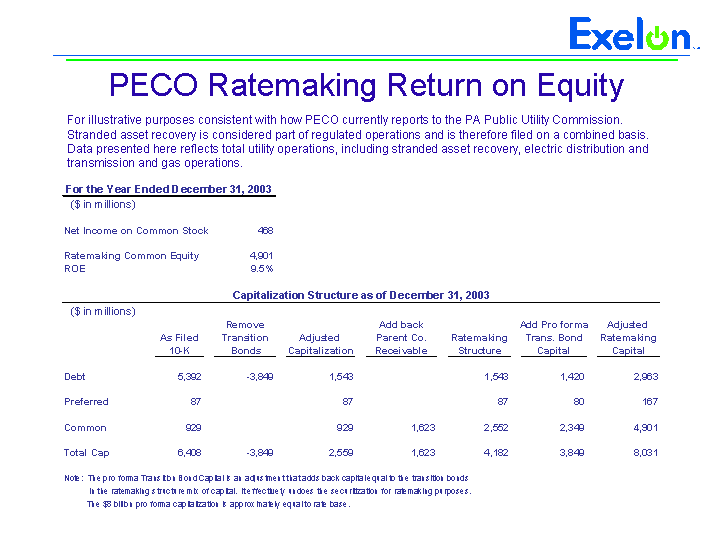
| PECO Ratemaking Return on Equity For illustrative purposes consistent with how PECO currently reports to the PA Public Utility Commission. Stranded asset recovery is considered part of regulated operations and is therefore filed on a combined basis. Data presented here reflects total utility operations, including stranded asset recovery, electric distribution and transmission and gas operations. |
ComEd Restructuring Legislation
Enacted Dec. 1997
Rate Reductions
| • | Residential - | 15% effective 1/1/98 ~ $400 million | ||
| 5% effective 10/1/2001 ~ $100 million | ||||
| Direct Access Phase-In Schedule | ||||
| • | Residential | |||
| 5/1/2002 | 100% of residential customers have supplier choice. | |||
| • | Commercial and Industrial, Governmental | |||
All C&I customers had supplier choice effective 12/31/00.
Transition Cost Recovery Provisions
| 1) | Bundled rates are frozen through 2006 (originally 2004) at 1996 levels after taking the residential rate reductions described above. | |||
| 2) | Unbundled delivery service rates apply to customers who choose an alternate supplier or the market rate for energy (ComEd PPO). | |||
| • | Utilities recover transition costs via a Competitive Transition Charge (CTC) from customers who select an alternate supplier. The CTC will apply through 2006 for all classes. The CTC will be calculated based on the following formula: |
| CTC = | Tariff/contract revenuesminus Delivery service revenueminus Market value of electricityminus Mitigation factor |
(See current and proposed delivery rate schedules attached.)
Mitigation Factor
The mitigation factor is a credit averaging 0.5 cents/kWh offered by the utility to delivery service only customers.
| • | The mitigation factor for commercial and industrial customers is: |
| 10/1/99-12/31/02 | 0.5 cents per kWh or 8% | |
| 2003-2004 | 0.5 cents per kWh or 10% | |
| 2005 | 0.6 cents per kWh or 11% | |
| 2006 | 0.9 cents per kWh or 12% |
| • | The mitigation factor for residential customers is calculated as a percentage of base rates after the rate reductions are in effect. The applicable percentages are as follows: |
| 2002 | 6% of base rates after rate reductions | |
| 2003-2004 | 7% of base rates after rate reductions | |
| 2005 | 8% of base rates after rate reductions | |
| 2006 | 10% of base rates after rate reductions |
Transition Period Provision
During the transition period utilities will be able to recognize, sell or assign assets; retire or remove plants from service; unbundle or restructure tariffs on a revenue neutral basis (with impact limitations described in Earnings and Viability below); accelerate depreciation or amortization or assets without ICC approval. The ICC could intercede if it believed the transaction jeopardized reliable service.
Earnings and Viability
The maximum allowable rate of return will be pegged to the 30-year T-Bond rate, plus 8.5%. If earnings exceed the allowed rate of return by more than 1.5%, 50% of the excess earnings would be shared with customers. If the rate of return is below the T-bond Rate, the utilities can apply to the ICC for a rate increase.
Securitization
Utilities are allowed to utilize securitization of transition period revenues as a means to mitigate stranded costs. The proceeds primarily are to be used to retire debt and equity, and to repay or retire fuel obligations if the Commission finds such use is the public interest.
Amount allowable for securitization is capped by 50% of capitalization. In December 1998, ComEd securitized $3.4 billion.
2
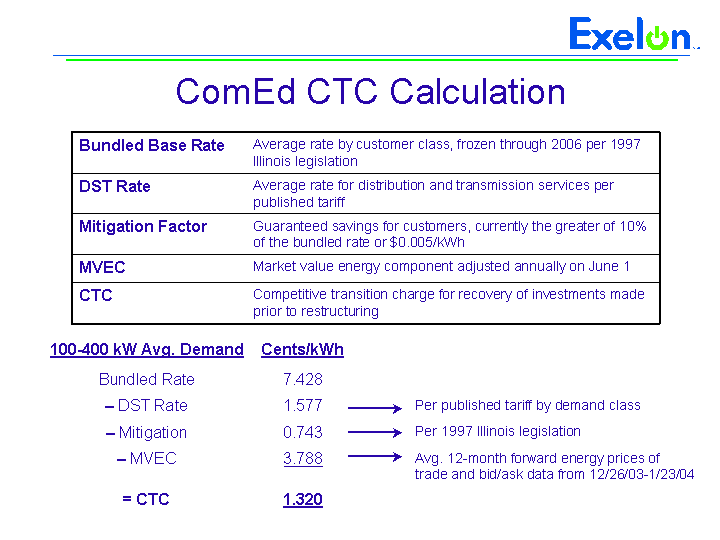
| ComEd CTC Calculation Bundled Base Rate Average rate by customer class, frozen through 2006 per 1997 Illinois legislation DST Rate Average rate for distribution and transmission services per published tariff Mitigation Factor Guaranteed savings for customers, currently the greater of 10% of the bundled rate or $0.005/kWh MVEC Market value energy component adjusted annually on June 1 CTC Competitive transition charge for recovery of investments made prior to restructuring 100-400 kW Avg. Demand Cents/kWh Bundled Rate 7.428 - DST Rate 1.577 Per published tariff by demand class - Mitigation 0.743 Per 1997 Illinois legislation - MVEC 3.788 Avg. 12-month forward energy prices of trade and bid/ask data from 12/26/03-1/23/04 = CTC 1.320 |
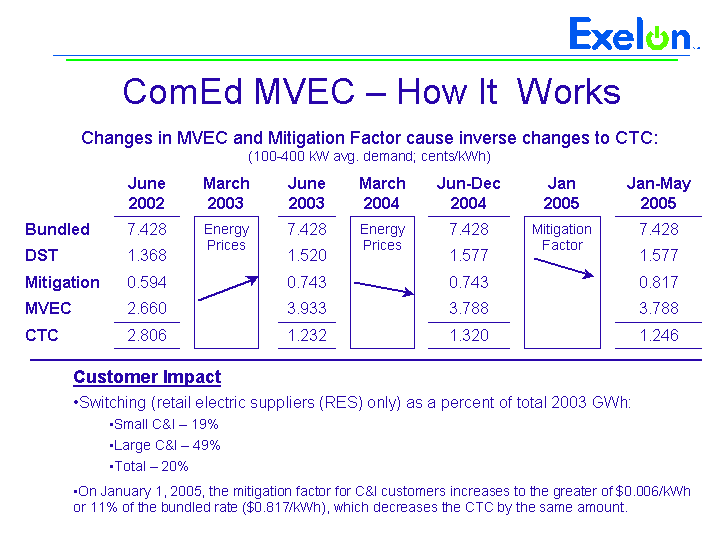
| ComEd MVEC - How It Works June 2002 March 2003 June 2003 March 2004 Jun-Dec 2004 Jan 2005 Jan-May 2005 Bundled 7.428 Energy Prices 7.428 Energy Prices 7.428 Mitigation Factor 7.428 DST 1.368 Energy Prices 1.520 Energy Prices 1.577 Mitigation Factor 1.577 Mitigation 0.594 Energy Prices 0.743 Energy Prices 0.743 Mitigation Factor 0.817 MVEC 2.660 Energy Prices 3.933 Energy Prices 3.788 Mitigation Factor 3.788 CTC 2.806 Energy Prices 1.232 Energy Prices 1.320 Mitigation Factor 1.246 Changes in MVEC and Mitigation Factor cause inverse changes to CTC: (100-400 kW avg. demand; cents/kWh) Customer Impact Switching (retail electric suppliers (RES) only) as a percent of total 2003 GWh: Small C&I - 19% Large C&I - 49% Total - 20% On January 1, 2005, the mitigation factor for C&I customers increases to the greater of $0.006/kWh or 11% of the bundled rate ($0.817/kWh), which decreases the CTC by the same amount. |
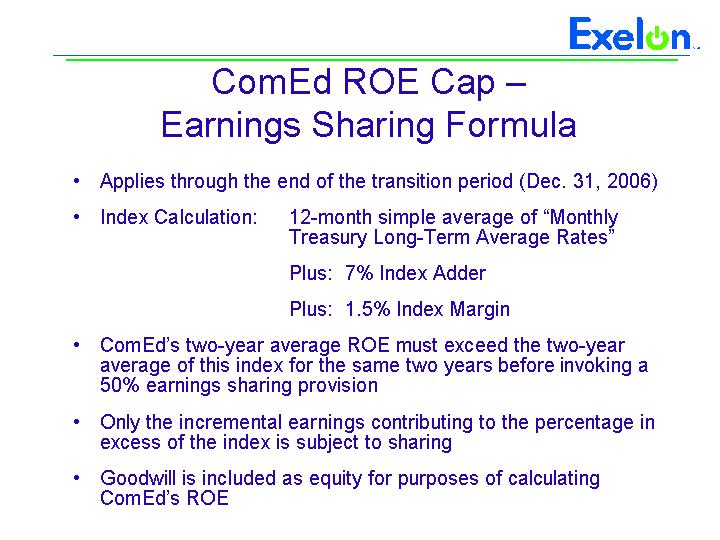
| ComEd ROE Cap - Earnings Sharing Formula Applies through the end of the transition period (Dec. 31, 2006) Index Calculation: 12-month simple average of "Monthly Treasury Long-Term Average Rates" Plus: 7% Index Adder Plus: 1.5% Index Margin ComEd's two-year average ROE must exceed the two-year average of this index for the same two years before invoking a 50% earnings sharing provision Only the incremental earnings contributing to the percentage in excess of the index is subject to sharing Goodwill is included as equity for purposes of calculating ComEd's ROE |
| Commonwealth Edison Company | May 28, 2004 |
Based on Market Value Defined in Rider PPO — Power Purchase Option (Market Index) Applicable Period A (June 2004 — May 2005)
(All units are in cents per kilowatt-hour)
| 2004 | ||||||||||||||||
| Base Rate Revenue | Delivery Service | Mitigation | ||||||||||||||
| (1) (2) | Revenue (3) | Market Value (4) | Amount (5) | |||||||||||||
| (A) | (B) | (C) | (D) | |||||||||||||
| Customer Transition Charge Customer Class | ||||||||||||||||
| Residential Delivery Service Customers | ||||||||||||||||
| Single Family Without Space Heat | 8.715 | 3.372 | 3.890 | 0.610 | ||||||||||||
| Multi Family Without Space Heat | 8.961 | 4.448 | 4.023 | 0.627 | ||||||||||||
| Single Family With Space Heat | 5.836 | 2.335 | 3.598 | 0.409 | ||||||||||||
| Multi Family With Space Heat | 6.169 | 2.896 | 3.649 | 0.432 | ||||||||||||
| Fixture-included Lighting Residential Delivery Service Customers | 8.655 | 9.905 | 2.809 | 0.606 | ||||||||||||
[Continued from above table, first column(s) repeated]
| 2005 | ||||||||||||
| June 2004 — December 31, 2004 | Mitigation | January 1, 2005 — May 2005 | ||||||||||
| CTC | Amount (6) | CTC | ||||||||||
| (E) = (A) - (B) - (C) - (D) | (F) | (G) = (A) - (B) - (C) - (F) | ||||||||||
| Customer Transition Charge Customer Class | ||||||||||||
| Residential Delivery Service Customers | ||||||||||||
| Single Family Without Space Heat | 0.843 | 0.697 | 0.756 | |||||||||
| Multi Family Without Space Heat | 0.000 | 0.717 | 0.000 | |||||||||
| Single Family With Space Heat | 0.000 | 0.467 | 0.000 | |||||||||
| Multi Family With Space Heat | 0.000 | 0.494 | 0.000 | |||||||||
| Fixture-included Lighting Residential Delivery Service Customers | 0.000 | 0.692 | 0.000 | |||||||||
Notes:
| (1) | Based on three years of residential historical data ending January 2002 and residential rates in effect beginning October 1, 2001. | |||
| (2) | Base rate revenues consist of customer service and energy charges. Base rate revenues do not include facility, meter, or other equipment rentals, franchise fees or other franchise cost additions, fuel adjustment clause charges, decommissioning expense adjustment clause charges, taxes, local government compliance clause charges, compensation for energy generated by a person or entity other than ComEd, or Renewable Energy Resources and Coal Technology Development Assistance Charge and Energy Assistance Charge for the Supplemental Low-Income Energy Assistance Fund. | |||
| (3) | The amount of revenue that the Company would receive under Rate RCDS — Retail Customer Delivery Service (Rate RCDS) and Rider TS — Transmission Services (Rider TS) for standard delivery of energy to customers in the CTC Customer Class. | |||
| (4) | The Market Value for a CTC Customer Class has the same value as the per kilowatt-hour Load Weighted Average Market Value (LWAMV) as defined in Rider PPO — Power Purchase Option (Market Index) for the applicable delivery service customer class. | |||
| (5) | The residential mitigation amount as defined in Rate CTC is 7% of the base rate revenue for the calendar year 2004. | |||
| (6) | The residential mitigation amount as defined in Rate CTC is 8% of the base rate revenue for the calendar year 2005. | |||

| Commonwealth Edison Company | May 28, 2004 |
Based on Market Value Defined in Rider PPO — Power Purchase Option (Market Index) Applicable Period A (June 2004 — May 2005)
(All units are in cents per kilowatt-hour)
| 2004 | ||||||||||||||||
| Base Rate Revenue | Delivery Service | Mitigation | ||||||||||||||
| (1) (2) | Revenue (1) (3) | Market Value (4) | Amount (5) | |||||||||||||
| (A) | (B) | (C) | (D) | |||||||||||||
| Customer Transition Charge Customer Class | ||||||||||||||||
| Nonresidential Delivery Service Customers | ||||||||||||||||
| With Only Watt-hour Only Meters | 11.258 | 3.787 | 3.934 | 1.126 | ||||||||||||
| 0 kW to and including 25 kW Demand | 9.288 | 2.202 | 3.832 | 0.929 | ||||||||||||
| Over 25 kW to and including 100 kW Demand | 8.344 | 1.958 | 3.826 | 0.834 | ||||||||||||
| Over 100 kW to and including 400 kW Demand | 7.428 | 1.577 | 3.788 | 0.743 | ||||||||||||
| Fixture-included Lighting Nonresidential Delivery Service Customers | 13.554 | 9.905 | 2.788 | 1.355 | ||||||||||||
| Street Lighting Delivery Service Customers — Dusk to Dawn | 3.852 | 1.954 | 2.777 | 0.500 | ||||||||||||
| Street Lighting Delivery Service Customers — All Other Lighting | 7.172 | 1.923 | 3.381 | 0.717 | ||||||||||||
| Railroad Delivery Service Customers (9) | ||||||||||||||||
| Pumping Delivery Service Customers | 6.465 | 1.523 | 3.514 | 0.647 | ||||||||||||
[Continued from above table, first column(s) repeated]
| 2005 | ||||||||||||
| June 2004 — December 31, 2004 | Mitigation | January 1, 2005 — May 2005 | ||||||||||
| CTC (6) (7) | Amount (8) | CTC (6,7) | ||||||||||
| (E) = (A) - (B) - (C) - (D) | (F) | (G) = (A) - (B) - (C) - (F) | ||||||||||
| Customer Transition Charge Customer Class | ||||||||||||
| Nonresidential Delivery Service Customers | ||||||||||||
| With Only Watt-hour Only Meters | 2.411 | 1.238 | 2.299 | |||||||||
| 0 kW to and including 25 kW Demand | 2.325 | 1.022 | 2.232 | |||||||||
| Over 25 kW to and including 100 kW Demand | 1.726 | 0.918 | 1.642 | |||||||||
| Over 100 kW to and including 400 kW Demand | 1.320 | 0.817 | 1.246 | |||||||||
| Fixture-included Lighting Nonresidential Delivery Service Customers | 0.000 | 1.491 | 0.000 | |||||||||
| Street Lighting Delivery Service Customers — Dusk to Dawn | 0.000 | 0.600 | 0.000 | |||||||||
| Street Lighting Delivery Service Customers — All Other Lighting | 1.151 | 0.789 | 1.079 | |||||||||
| Railroad Delivery Service Customers (9) | ||||||||||||
| Pumping Delivery Service Customers | 0.781 | 0.711 | 0.717 | |||||||||
Notes:
| (1) | Transfer from Column (H) and Column (M) of Determination of Customer Transition Charge, on Pages 2 to 9 of attached work papers. | |||
| (2) | Base rate revenues consist of customer, demand, and energy charges. Base rate revenues do not include facility, meter, or other equipment rentals, franchise fees or other franchise cost additions, fuel adjustment clause charges, decommissioning expense adjustment clause charges, taxes, local government compliance clause charges, compensation for energy generated by a person or entity other than ComEd, or Renewable Energy Resources and Coal Technology Development Assistance Charge and Energy Assistance Charge for the Supplemental Low-Income Energy Assistance Fund. | |||
| (3) | The amount of revenue that the Company would receive under Rate RCDS — Retail Customer Delivery Service (Rate RCDS) and Rider TS — Transmission Services (Rider TS) for standard delivery of energy to customers in the CTC Customer Class. | |||
| (4) | The Market Value for a CTC Customer Class has the same value as the per kilowatt-hour Load Weighted Average Market Value (LWAMV) as defined in Rider PPO — Power Purchase Option (Market Index) for the applicable customer class for Applicable Period A. | |||
| (5) | The mitigation amount as defined in Rate CTC is the greater of 0.5 cents per kilowatt-hour or 10% of the base rate revenue for the calendar year 2004. | |||
| (6) | This Applicable Period A Customer Transition Charge (CTC) is not applicable if you are taking service under a multi-year CTC option under Rider CTC — MY — Customer Transition Charges — Multi-Year (Rider CTC-MY). | |||
| (7) | CTCs are subject to change without specific notice if one of the components used in the determination of the CTC, as described in Rate CTC, is modified. If the CTC is equal to zero, this account will not be eligible for service under Rider PPO — Power Purchase Option (Market Index) (Rider PPO). | |||
| (8) | The mitigation amount as defined in Rate CTC is the greater of 0.6 cents per kilowatt-hour or 11% of the base rate revenue for the calendar year of 2005. | |||
| (9) | There are two customers in the Railroad class and each customer will have a Customer-specific CTC. | |||

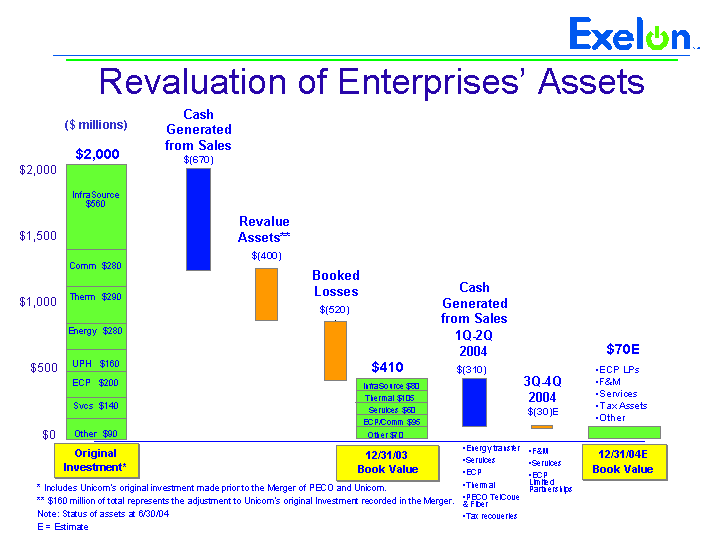
| Initial Investment Asset Sales UPH ECP Net Investment Thermal Eval ECP Energy Closed Ops Other 4/30/02 BV East 2 1.33 0.93 0.47 0.13 0.069 West North 1.33 0.93 0.47 0.13 0.1 0 Original Investment* $2,000 $(670) $(400) $(520) InfraSource $560 Comm $280 Therm $290 Energy $280 UPH $160 ECP $200 Svcs $140 Other $90 $(310) Cash Generated from Sales Booked Losses $2,000 $0 $1,000 $1,500 $500 ($ millions) Revaluation of Enterprises' Assets 1Q-2Q 2004 3Q-4Q 2004 $(30)E $70E ECP LPs F&M Services Tax Assets Other 12/31/04E Book Value * Includes Unicom's original investment made prior to the Merger of PECO and Unicom. ** $160 million of total represents the adjustment to Unicom's original Investment recorded in the Merger. Note: Status of assets at 6/30/04 E = Estimate 12/31/03 Book Value $410 Thermal $105 Services $60 Other $70 InfraSource $80 ECP/Comm $95 Energy transfer Services ECP Thermal PECO TelCove & Fiber Tax recoveries F&M Services ECP Limited Partnerships Revalue Assets** Cash Generated from Sales |
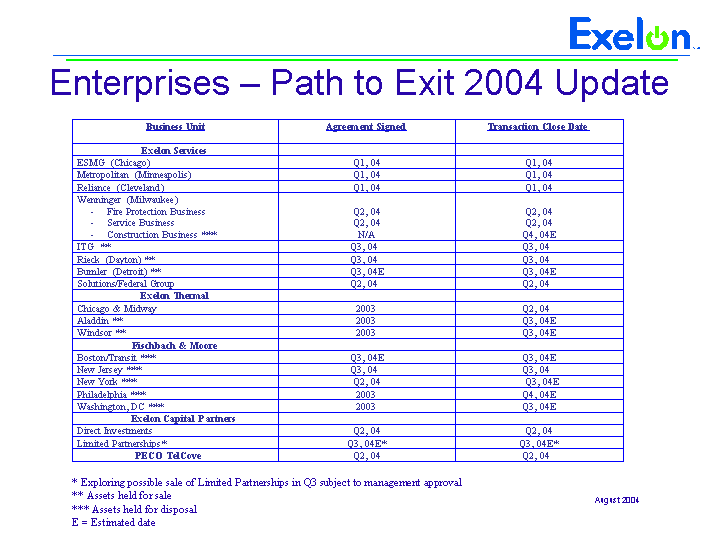
| Enterprises - Path to Exit 2004 Update * Exploring possible sale of Limited Partnerships in Q3 subject to management approval ** Assets held for sale *** Assets held for disposal E = Estimated date Business Unit Agreement Signed Transaction Close Date Exelon Services ESMG (Chicago) Q1, 04 Q1, 04 Metropolitan (Minneapolis) Q1, 04 Q1, 04 Reliance (Cleveland) Q1, 04 Q1, 04 Wenninger (Milwaukee) - - Fire Protection Business - - Service Business - - Const ruction Business *** Q2, 04 Q2, 04 N/A Q2, 04 Q2, 04 Q4, 04E ITG ** Q3, 04 Q3, 04 Rieck (Dayton) ** Q3, 04 Q3, 04 Bumler (Detroit) ** Q3, 04E Q3, 04E Solutions/Federal Group Q2, 04 Q2, 04 Exelon Thermal Chicago & Midway 2003 Q2, 04 Aladdin ** 2003 Q3, 04E Windsor ** 2003 Q3, 04E Fischbach & Moore Boston/Transit *** Q3, 04E Q3, 04E New Jersey *** Q3, 04 Q3, 04 New York *** Q2, 04 Q3, 04E Philadelphia *** 2003 Q4, 04E Washington, DC *** 2003 Q3, 04E Exelon Capital P artners Direct Investments Q2, 04 Q2, 04 Limited Partnerships* Q3, 04E* Q3, 04E* PECO TelCove Q2, 04 Q2, 04 August 2004 |
Exelon Corporation
Transitional Bond Summary
| ($ in millions) | Dec-00 | Dec-01 | Dec-02 | Dec-03 | Dec-04 | Dec-05 | Dec-06 | Dec-07 | Dec-08 | Dec-09 | Dec-10 | |||||||||||||||||||||||||||||||||
ComEd | ||||||||||||||||||||||||||||||||||||||||||||
| Year End Principal Balance | $ | 2,720 | $ | 2,380 | $ | 2,040 | $ | 1,700 | $ | 1,360 | $ | 1,020 | $ | 680 | $ | 340 | $ | — | $ | — | $ | — | ||||||||||||||||||||||
| Principal Payments | $ | 340 | $ | 340 | $ | 340 | $ | 340 | $ | 340 | $ | 340 | $ | 340 | $ | 340 | $ | — | $ | — | ||||||||||||||||||||||||
PECO | ||||||||||||||||||||||||||||||||||||||||||||
| Year End Principal Balance | $ | 4,838 | $ | 4,582 | $ | 4,255 | $ | 4,015 | $ | 3,725 | $ | 3,295 | $ | 2,775 | $ | 2,135 | $ | 1,505 | $ | 805 | $ | — | ||||||||||||||||||||||
| Principal Payments | $ | 256 | $ | 327 | $ | 240 | $ | 290 | $ | 430 | $ | 520 | $ | 640 | $ | 630 | $ | 700 | $ | 805 | ||||||||||||||||||||||||
Total | ||||||||||||||||||||||||||||||||||||||||||||
| Year End Principal Balance | $ | 7,558 | $ | 6,962 | $ | 6,295 | $ | 5,715 | $ | 5,085 | $ | 4,315 | $ | 3,455 | $ | 2,475 | $ | 1,505 | $ | 805 | $ | — | ||||||||||||||||||||||
| Principal Payments | $ | 596 | $ | 667 | $ | 580 | $ | 630 | $ | 770 | $ | 860 | $ | 980 | $ | 970 | $ | 700 | $ | 805 | ||||||||||||||||||||||||

August 2004
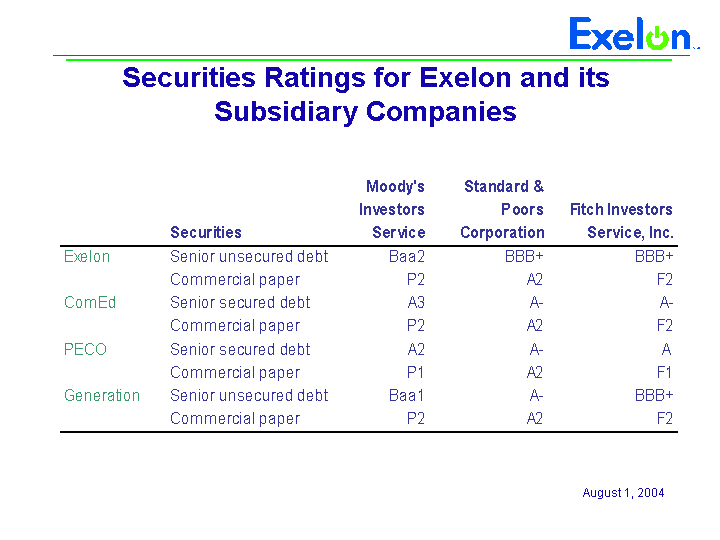
| Securities Ratings for Exelon and its Subsidiary Companies August 1, 2004 |